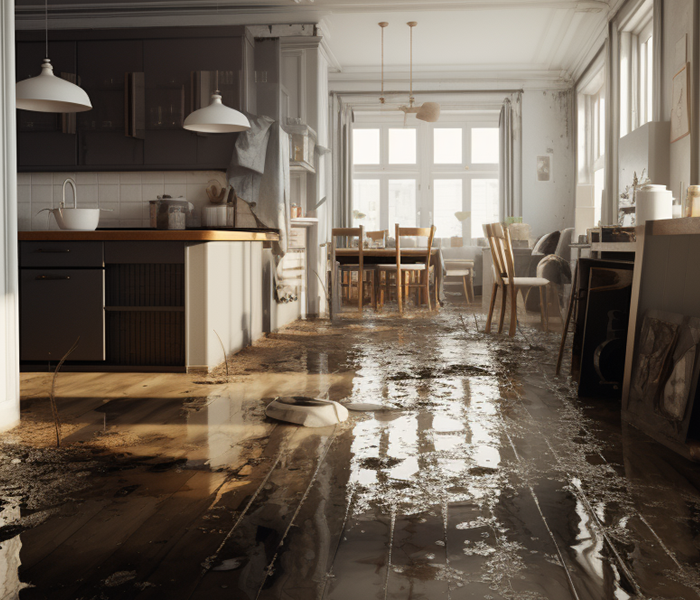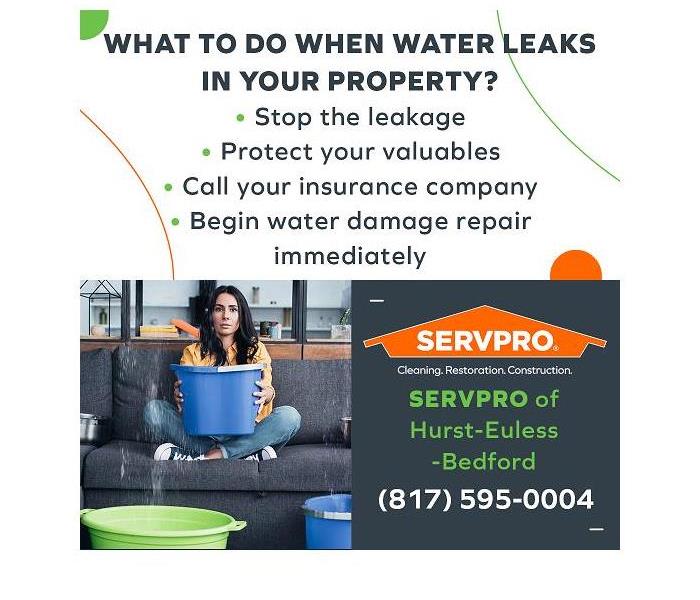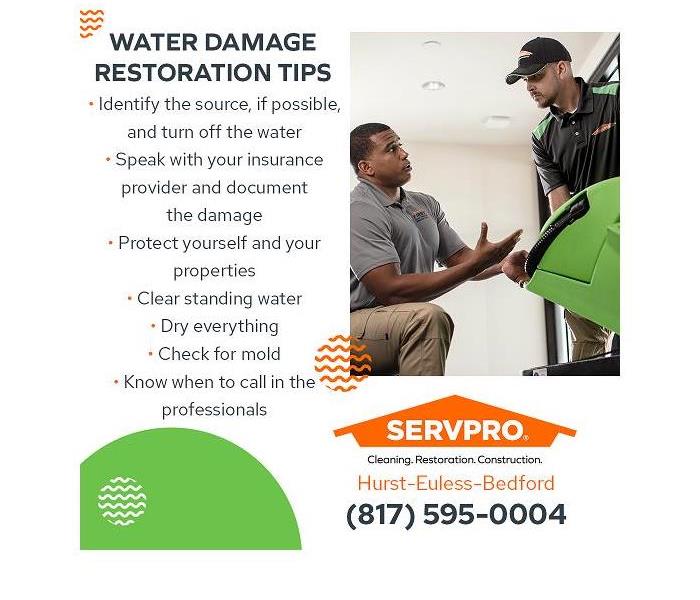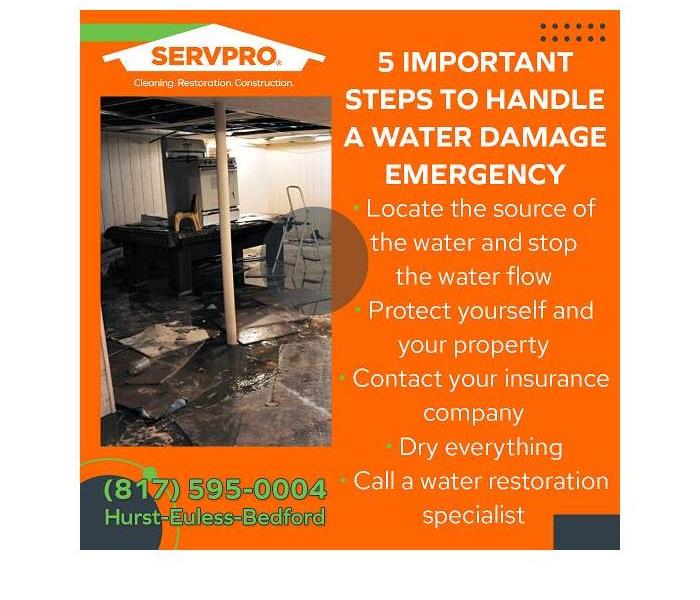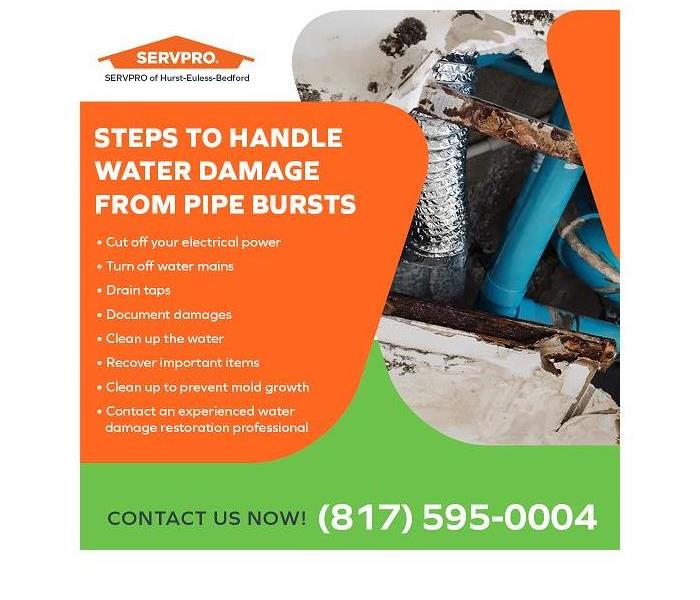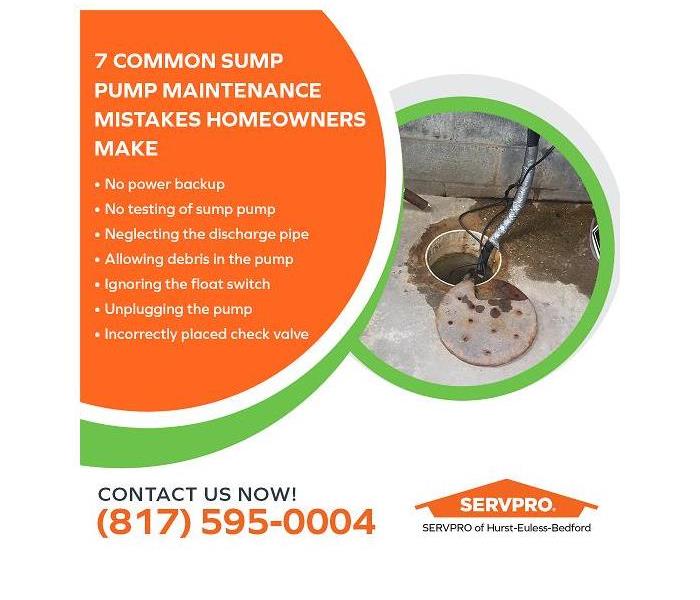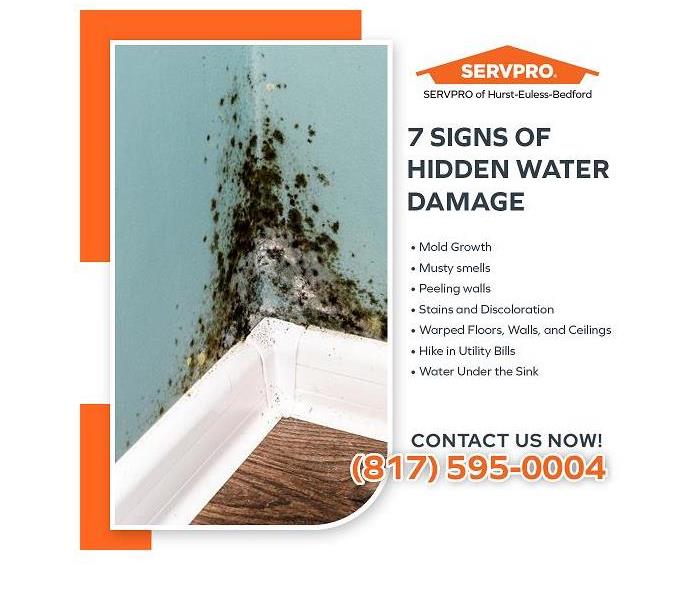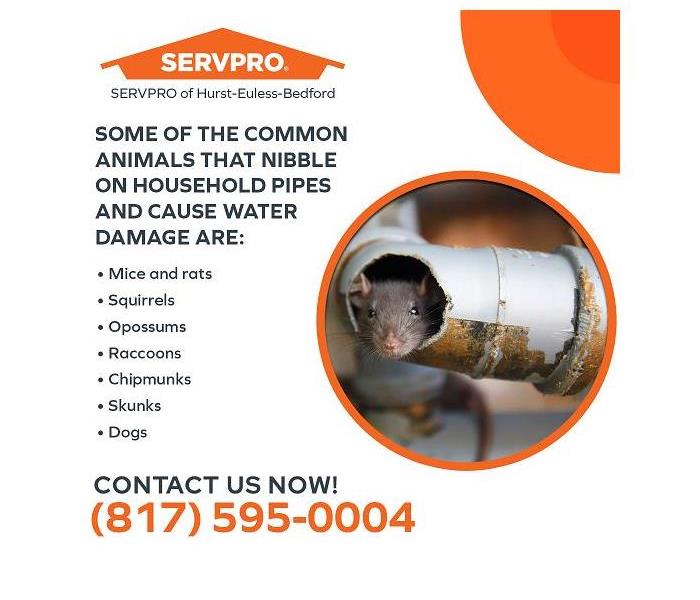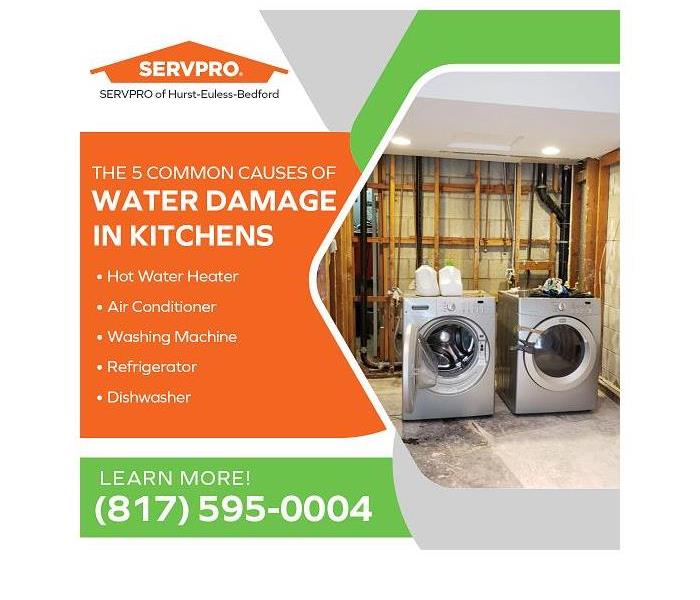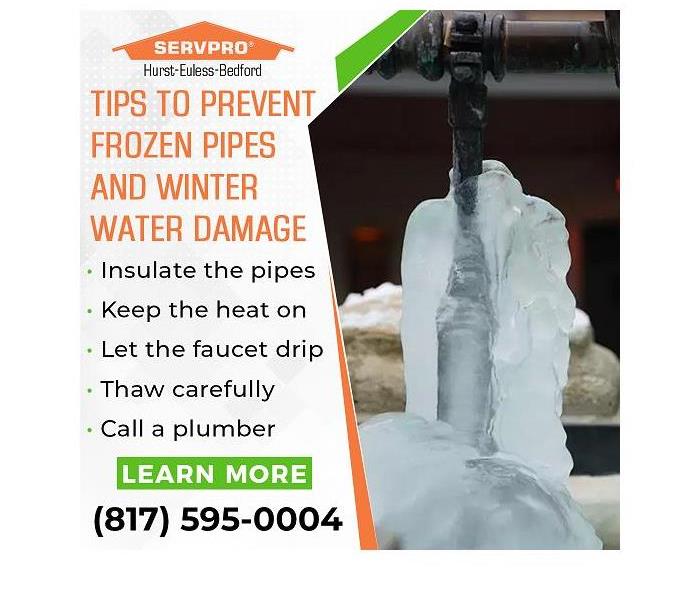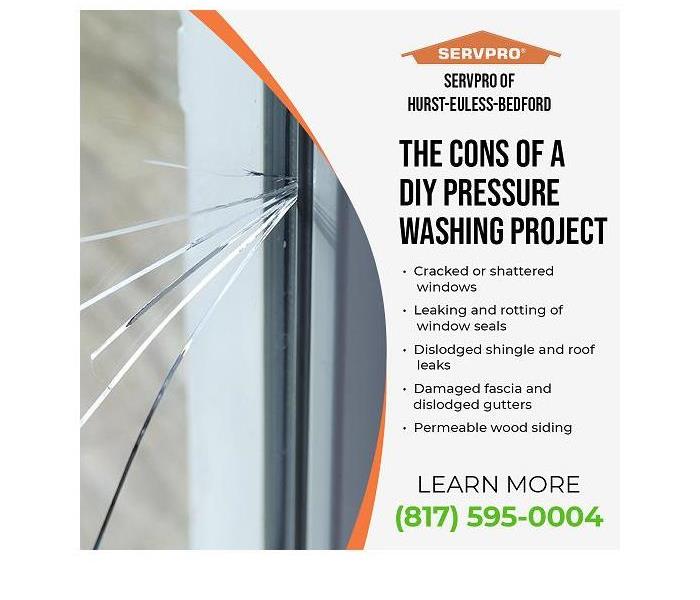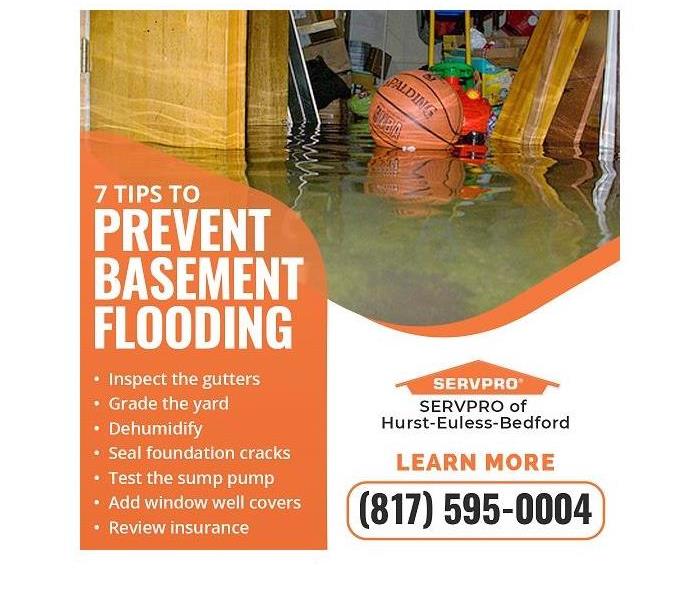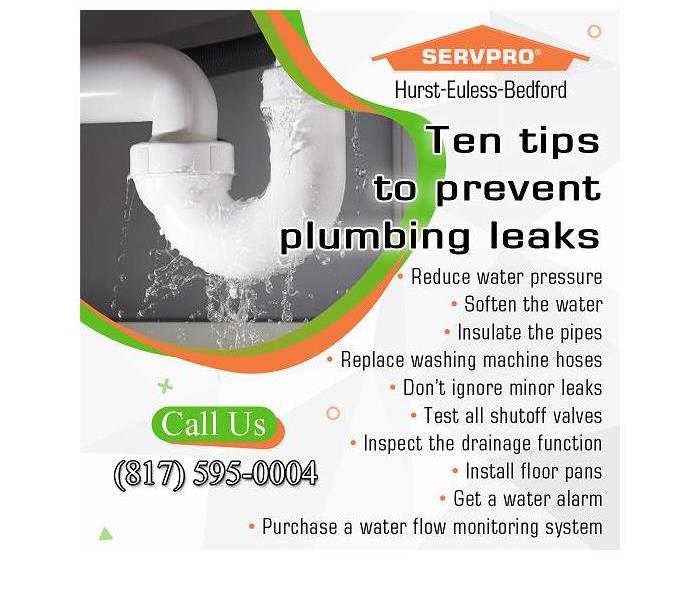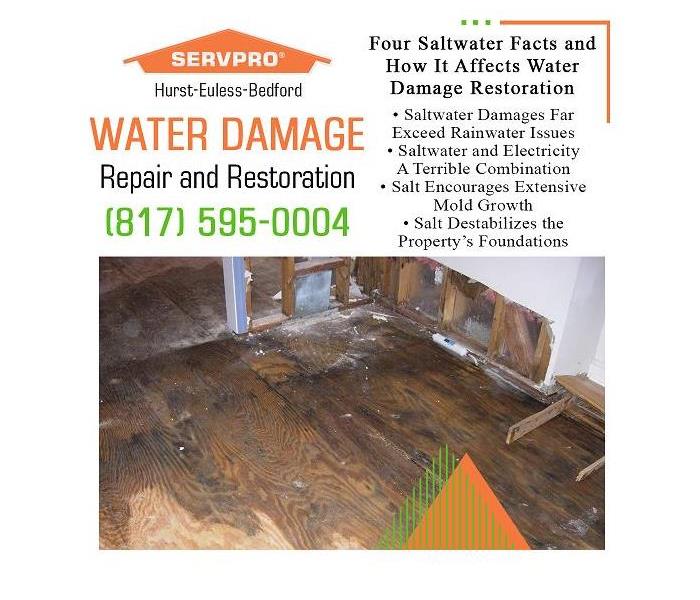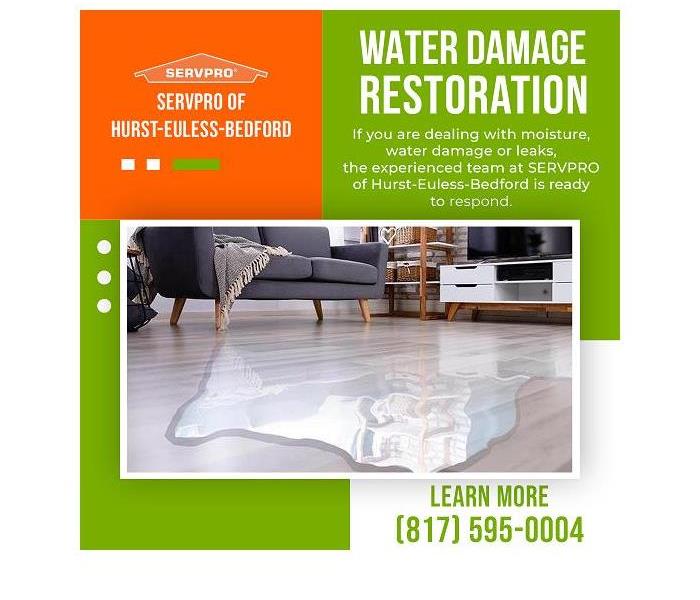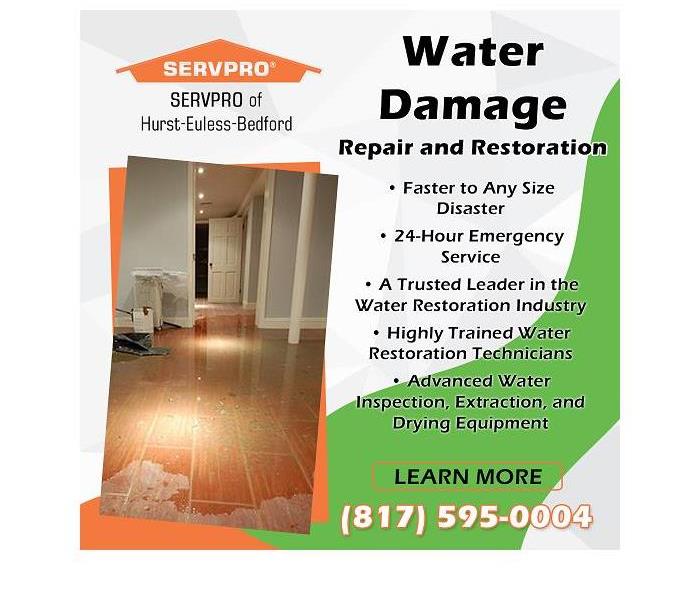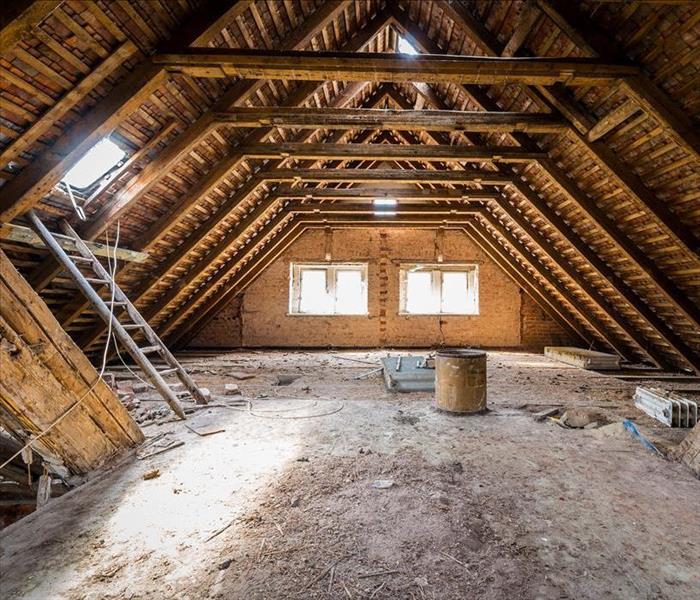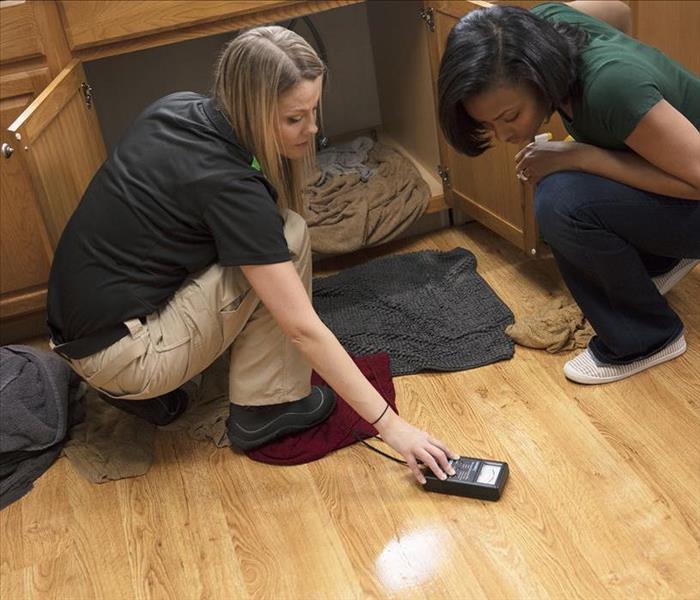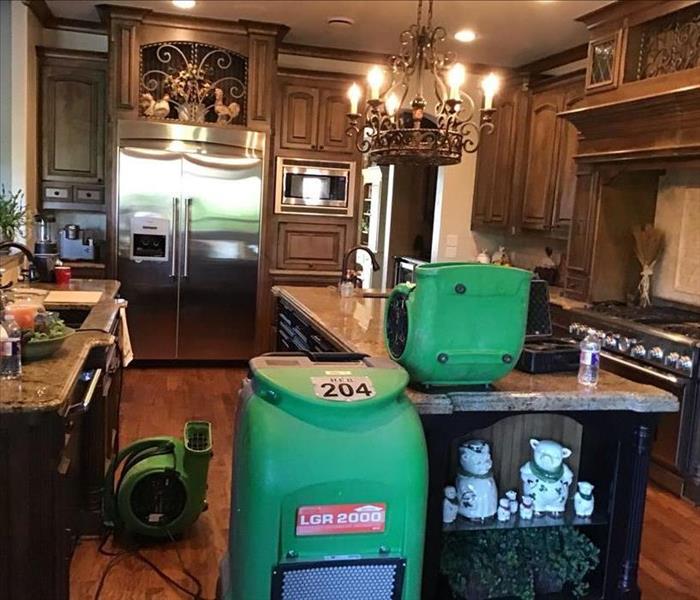Recent Water Damage Posts
Preventing Water Damage: Essential Tips for Homeowners
3/11/2025 (Permalink)
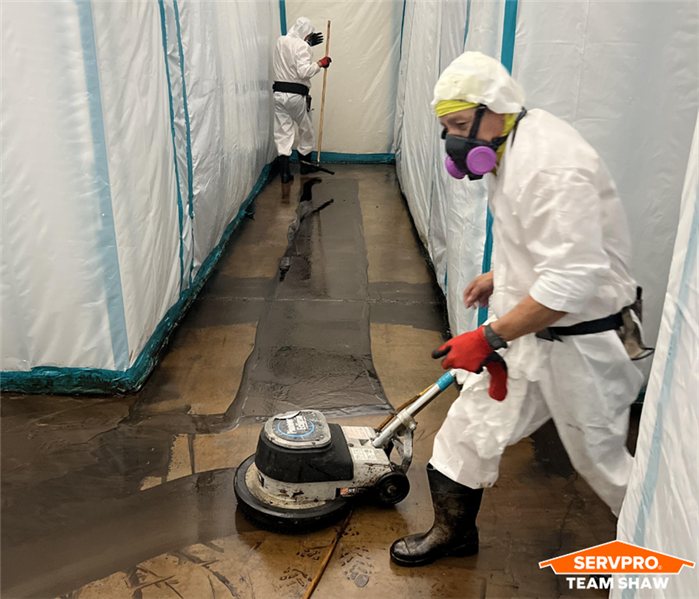 A SERVPRO technician restoring a building.
A SERVPRO technician restoring a building.
Water damage can be costly and stressful, but taking a few proactive steps can help protect your home. Whether it's from heavy rain, burst pipes, or appliance leaks, preventing water damage starts with regular maintenance and awareness.
Key Tips to Prevent Water Damage:
Check for Leaks Regularly – Inspect pipes, faucets, and under sinks for any signs of leaks. Catching small drips early can prevent major water damage.
Clean Gutters & Downspouts – Clogged gutters can cause water to overflow and seep into your home’s foundation, leading to structural issues. Make sure they’re clear, especially before storm seasons.
Inspect Your Roof – Missing or damaged shingles can allow water to leak into your attic. Regular roof inspections help prevent leaks before they start.
Monitor Water Pressure – High water pressure can strain pipes, increasing the risk of leaks or bursts. A water pressure regulator can help maintain safe levels.
Know Where Your Water Main Shutoff Is – In case of an emergency, shutting off your home’s main water supply quickly can minimize damage.
If water damage does occur, acting fast is key! SERVPRO® is available 24/7 to respond to water emergencies, providing expert drying, cleanup, and restoration services.
What to Do After Discovering Water Damage from Leaky Pipes
2/9/2024 (Permalink)
Water damage from leaky pipes can be a nightmare, but knowing what steps to take can make all the difference in minimizing the damage and getting your home back to its former state swiftly. At Team Shaw, we understand the urgency and stress that comes with water damage emergencies. That's why we've compiled this comprehensive guide to help you navigate through this challenging situation.
Safety First:
Before doing anything else, prioritize your safety and that of your family. Turn off the electricity and gas supply to the affected area to prevent any potential hazards.
If the water damage is extensive or if there's standing water, evacuate the area and wait for professionals like Team Shaw to assess the situation.
Assess the Damage:
Once it's safe to do so, assess the extent of the water damage. Look for visible signs such as soaked carpets, water stains on walls or ceilings, and warped or damaged flooring.
Take photos and videos of the damage for insurance purposes. Documenting the damage will help streamline the claims process.
Stop the Source:
If the leak is from a burst or leaky pipe, shut off the main water supply to your home immediately. This will prevent further water from entering your property and exacerbating the damage.
Remove Water and Moisture:
Use a wet/dry vacuum to remove standing water as quickly as possible. The longer water sits, the more damage it can cause.
Open windows and doors to promote airflow and aid in drying out the affected area. Utilize fans and dehumidifiers to speed up the drying process.
Protect Belongings:
Remove any furniture, rugs, and other belongings from the affected area to prevent further damage. Place them in a dry, safe location to air out.
Take special care with valuable or sentimental items. If necessary, consult with restoration professionals for specialized treatment.
Mitigate Mold Growth:
Mold can start to grow within 24-48 hours of water damage. To prevent mold growth, thoroughly dry affected areas and items.
Clean and disinfect surfaces with a solution of water and mild detergent to remove any potential contaminants.
Contact Professionals:
While you can take immediate steps to address water damage, it's crucial to enlist the help of professionals like Team Shaw for thorough restoration.
Our experienced team has the expertise and equipment to assess the damage, mitigate further issues, and restore your home to its pre-damaged condition.
Communicate with Insurance:
Contact your insurance provider as soon as possible to report the water damage and initiate the claims process.
Provide documentation, including photos, videos, and any receipts for expenses related to mitigation efforts.
Prevent Future Incidents:
Once the immediate crisis is resolved, take steps to prevent future water damage. Regularly inspect plumbing fixtures and pipes for leaks, and address any issues promptly.
Consider installing water leak detection devices or smart water shut-off valves for added protection and peace of mind.
Stay Informed and Prepared:
Educate yourself and your family members about emergency protocols in case of future water damage incidents.
Keep emergency contacts, including Team Shaw and your insurance provider, readily accessible.
In conclusion, experiencing water damage from leaky pipes can be overwhelming, but taking prompt and decisive action can mitigate the damage and help you get back on track sooner. Remember, Team Shaw is here to support you every step of the way, from initial assessment to complete restoration. Don't hesitate to reach out for assistance—we're just a phone call away. Stay safe and prepared!
5 tips to prevent water damage in your home
2/9/2023 (Permalink)
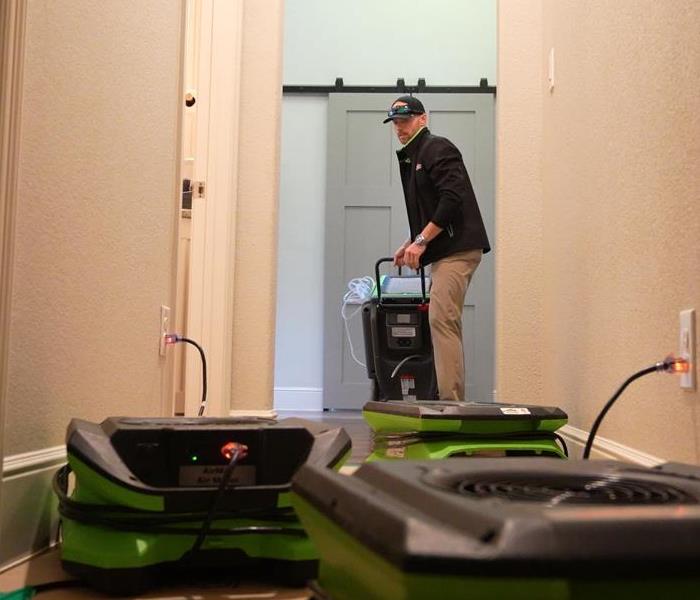 SERVPRO Team Shaw using specialized equipment to clean up water damage.
SERVPRO Team Shaw using specialized equipment to clean up water damage.
Water damage is one of the most common causes of property loss in homes across the country. Whether it's caused by burst pipes, flooding, or a leaking roof—water can cause serious damage to your home and possessions. Fortunately, there are steps you can take to prevent water damage before it becomes a costly problem. Here's what you need to know.
Check Pipes Regularly
One of the best ways to prevent water damage in your home is to regularly check your pipes for any signs of wear or corrosion. Check for leaks around faucets and showerheads, as well as any visible cracks or dents in the pipes themselves. If you notice anything amiss, have the pipe fixed or replaced ASAP before the issue escalates and causes further damage.
Maintain Your Roof
Your roof is another important area that needs regular maintenance if you want to protect your home from water damage. Be sure to keep an eye out for missing shingles and inspect for any signs of leakage after storms or heavy rainfalls.
Don't Neglect Appliances
Another potential source of water damage is faulty appliances such as washing machines and dishwashers. Make sure all hoses are securely connected and check them regularly for cracks or other signs of wear that could lead to a leak down the line. Consider investing in a shutoff valve so you can quickly turn off the water supply if needed—this could potentially save thousands in repair costs if something goes wrong with an appliance at home.
Check Your Gutters
Clogged gutters can cause rainwater to overflow onto your roof and into your walls, leading to extensive water damage over time. To prevent this from happening, make sure you clean out your gutters at least once a year. This will help ensure that they are free from debris such as leaves, twigs, and other materials that can block the flow of rainwater away from your home’s foundation. Additionally, check for any loose or missing shingles on the roof that could lead to water leakage into your attic or walls during a heavy rainfall. If needed, call a professional roofer for assistance in repairing any issues with your roof or gutters quickly.
Install Waterproofing Solutions
Waterproofing solutions such as sump pumps and battery-operated back-up systems can help protect against flooding in basements during severe storms by pumping excess moisture away from the foundation of the house before it has a chance to seep inside through cracks in the walls or floorboards. Installing waterproof wall membranes is also an effective way to keep out moisture while preventing mold growth which can lead to serious health issues in addition to costly property damage repairs down the line.
Texas emergency restoration: Why you need it after water damage
1/20/2023 (Permalink)
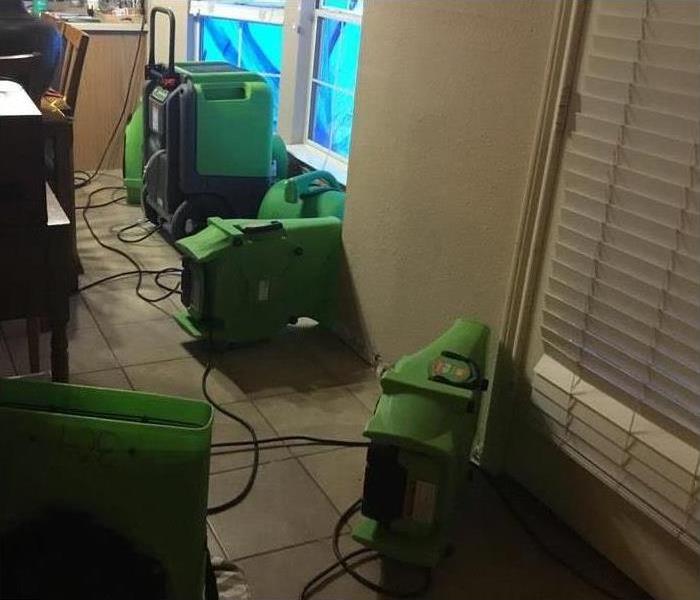 Air movers being used to clean up water damage in a home.
Air movers being used to clean up water damage in a home.
As a homeowner, you never want to be confronted with water damage. However, it’s important to know that when it happens, there are specialists who can help. Texas emergency restoration services are designed to restore your home and get it back to its pre-damage condition as quickly and efficiently as possible. Let’s discuss why this is so important.
Restoring Your Home Quickly
Time is of the essence when dealing with water damage. The longer the moisture remains in the house, the more likely secondary issues like mold and mildew will arise. Texas emergency restoration companies specialize in fast response times and quick turnaround times so that you can get your home back to normal without having to worry about additional problems caused by a delay in treatment.
Reducing Stress & Financial Burden
Water damage can be stressful enough as it is; you don’t need extra stressors added on top of it. That’s where Texas emergency restoration services come in handy. Not only do they make sure that your home is restored quickly, but they also provide estimates up front. This way, you can know what costs you’re looking at before any work even begins, and you can make sure that all repairs fit within your budget. On top of this, Texas emergency restoration companies will also work with your insurance company to help you maximize the money you have to restore your home.
High-Quality Workmanship & Service
Texas emergency restoration specialists understand how important it is for their workmanship to be top-notch quality—after all, this isn't just any repair job; this is someone's home we're talking about! As such, you can expect these experts to treat your situation with respect and care, while providing timely solutions backed by crucial professional knowledge and skill-sets. And if there are any issues down the road? They'll work with you until everything is resolved, no matter how long it takes!
When faced with water damage, time is of the essence, and you don't wait around for things to get worse! Because of this, it’s to get help from a team of experts that specializes in Texas emergency restoration services. This way,you can rest easy knowing that your home will be restored quickly and effectively while remaining within budget constraints.
SERVPRO of Hurst-Euless-Bedford explains how to deal with water damage in your home
12/20/2022 (Permalink)
Blog Summary: SERVPRO® of Hurst-Euless-Bedford explains the importance of hiring professionals to restore your home after water damage.
Water damage is one of the worst problems you can experience as a homeowner. It can be due to outside factors like flooding or faulty plumbing, leaking appliances, or other similar leakages inside the house.
Irrespective of how severe or insignificant the water damage looks, homeowners must ensure that their property is protected from further damage. The water damage restoration specialists at SERVPRO of Hurst-Euless-Bedford have outlined the steps homeowners need to take if there's water damage in their homes.
It’s important to know that water damage requires urgent attention from experts who will perform the restoration process. Any delay can cause structural problems to the home and can be risky for the health of the occupants. In as little as one day, mold can develop in the affected areas.
1. Stop the leakage
When you notice any water leakage in your property, the first step is to look for the source and find a way to stop the leakage. Once the leakage is eliminated, the proper water damage restoration process can begin. Stopping the leakage will ensure that the water doesn’t continue to add up pending the arrival of a restoration company.
Water removal professionals like SERVPRO of Hurst-Euless-Bedford offer 24-hour emergency services, making them a reliable option at any time of the day.
2. Protect yourself and your valuables
Once you’ve been able to stop the leakage, the next step is ensuring that everyone is safe and your properties are protected.
Turn off the power
Immediately turn off the power source to protect yourself and your family. Leaving the power on in the case of water damage can be a disaster waiting to happen. However, you should only attempt to turn the power off if the switch is located in a place that isn’t affected by water damage. If it is, you should call an electrician and get your family and pets out of the affected area.
Protect your valuables
To limit the potential damage to your properties, you can remove all the items and valuables that water can damage. For instance, remove all the furniture sitting on a carpet to minimize further damage, like severe staining on the carpet soaked in water.
3. Call your insurance company
You will also need to call your insurance company to discuss compensation. What your insurance covers depends on the kind of policy you have. The insurance company will have to determine if your insurance covers the loss you've suffered. Therefore, they will send someone to assess the damage.
It’s also essential for you to document everything before you begin cleanup. Take photos and make videos of the damage; it will be useful in helping the insurance company assess the damage.
4. Begin water damage repair immediately
Before, during, and after the damage repair process, it’s important to remember to document the damage your home has sustained. The photos and videos you make will come in handy when making insurance claims in the future.
If you’re dealing with extensive water damage, you should reach out to a water restoration company to ensure the process is done safely and efficiently without causing further damage.
A water damage restoration company like SERVPRO of Hurst-Euless-Bedford will work with your insurance company so that the whole claims process remains stress-free for you.
Get Professional water damage restoration services in Grand Prairie, TX
SERVPRO of Hurst-Euless-Bedford is one of the leading water restoration companies in the Grand Prairie, TX area. They have a team of efficient and well-trained professionals who will respond with advanced tools and equipment to help you mitigate the water damage and restore your property to its preloss state.
Call SERVPRO of Hurst-Euless-Bedford at (817) 595-0004 for emergency water damage restoration.
SERVPRO of Hurst-Euless-Bedford shares water damage restoration tips
11/17/2022 (Permalink)
Blog Summary: SERVPRO® of Hurst-Euless-Bedford outlines what you should do to restore your property after a water damage incident.
Water can be quite destructive when it gets into your property, from a burst pipe, roof leak, storm damage, sewage backup, or others. Below are steps you can take to quickly limit the damage and restore your property to its pre-damaged state:
1. Identify the source, if possible, and turn off the water
The first thing to do when faced with a water damage situation is to find the source of the water and turn it off. If you are dealing with a minor pipe leak or appliance leak, you can just find and turn off the water main.
However, when you are faced with a flooded property, you’ll need to take some extra steps, like turning off the electricity (if it’s outside) and wearing protective gear before venturing into the property to prevent electrocution.
If you can’t turn off the electricity, then you may need to call a technician or wait until the water/storm damage restoration company arrives.
2. Speak with your insurance provider and document the damage
Most basic property insurance policies cover water and storm damage restoration. So, it’s vital that you call your insurer immediately to inform them of the incident. Typically, they’ll schedule a loss assessment inspection. Some insurance companies may even provide you with a list of affiliated restoration companies you can use.
But, since you can’t wait until the inspection to start the restoration process, you’ll need to document the damage using photos and videos.
Take photos and make videos of all the affected areas and keep them for inspection. If you work with a restoration company like SERVPRO of Hurst-Euless-Bedford, they’ll provide other documents to back up your claim and work with your insurer to make the process seamless.
3. Protect yourself and your properties
Your safety and that of any other person within the property are paramount when dealing with water damage. If your property is flooded, you’ll need to look for temporary accommodation with friends and family or lodge in a hotel.
Once everyone is safely evacuated from the building and the electricity has been turned off, you can then start removing valuables and belongings to protect them.
Remove all paintings and wall hangings and take them to an unaffected part of your property or outside.
4. Clear standing water
It's essential to quickly take action when there is too much standing water on your property. The harmful impacts could extend deeper the longer you delay. To clear out the water, you’ll need a bucket, mop, or even a pumping machine if it’s a flood or massive storm damage restoration.
5. Dry everything
The next step is to dry the structures of your property and belongings to eliminate any hidden moisture. Professional water and Storm damage restoration experts have modern tools like moisture detectors, industrial fans, and dehumidifiers to dry every part of your property.
6. Check for mold
Mold can form within 24 hours after a water damage incident. So, checking for mold is a vital part of cleaning and making your property livable again.
Professional restoration companies like SERVPRO of Hurst-Euless-Bedford will remove any mold found and sterilize the affected areas to prevent redevelopment.
7. Know when to call in the professionals
‘DIYing’ is never advised when it comes to storm damage restoration and medium-to large-scale water damage restoration.
Hiring professional water damage restoration services will ensure the disaster is taken care of quickly and efficiently. You can rest assured that you won’t experience cases of mold development or property damage due to inadequate restoration.
Get professional restoration services in Euless
SERVPRO of Hurst-Euless-Bedford has a team of experienced water restoration specialists you can trust for your water/storm damage restoration needs in Euless. Their IICRC-certified water damage restoration specialists help homeowners and businesses overcome disasters of all kinds, from storm damage to flooding, pipe leaks, and others.
Call SERVPRO of Hurst-Euless-Bedford at (817) 595-0004 to request their services.
SERVPRO of Hurst-Euless-Bedford outlines 5 steps to handling a water damage emergency
9/23/2022 (Permalink)
Blog Summary: Are you faced with a water damage emergency? Here’s what you should do.
Having a clear plan in place that you can quickly put into action is the golden rule for dealing with any emergency crisis in your home or business.
If you wait too long to take action, a water damage crisis will only get worse. This is why it’s important to act quickly to stop the damage.
SERVPRO of Hurst-Euless-Bedford is a Hurst water damage restoration company offering residential and commercial water damage restoration services. Their team has outlined the following steps for handling a water damage emergency.
1. Locate the source of the water and stop the water flow
The first and most crucial action is to stop the water flow. If the water damage was caused by a pipe burst, then you’ll need to turn off the mains to cut off water flow to the leaky pipe. If the water was caused by a malfunctioning appliance like a washing machine, then you can turn it off from the bathroom.
However, you obviously won’t be able to stop flooding due to rainfall or a sewage backup. Be sure to turn off the electricity and gas when dealing with a flood.
2. Protect yourself and your property
Water damage in all its forms can endanger your well-being and safety due to contaminated water, flood threats, and mold growth. So you must take steps to protect yourself.
If your home is at risk of flooding, leave the area until the authorities say it's safe for you to come back. Wear rubber gloves, water-resistant boots, and protective gear when you return to the property. Save the most valuable things such as valuable documents, paintings, or gadgets.
3. Contact your insurance company
Get in touch with your insurance provider to find out how they handle water removal and flood restoration. Most insurance companies employ specialists who deal with water damage remediation to evaluate the damage and determine the appropriate amount of claims.
Take pictures of the damaged areas and any valuables that were also affected. Keep thorough records and invoices of all water removal and repair expenses.
- Dry everything
Once you’ve documented the damage, then it’s time to start the proper water damage restoration. While this may sound simple, it’s always best to leave it to a water damage restoration professional, as they have the tools and experience to do it properly.
The restoration process begins with water removal, where any standing water is removed from the house. Next is to dry every affected part of the property’s structure to get rid of all moisture. This is vital as any moisture left behind can permeate into the property structure and weaken it, causing mold growth. Once dried, the space will be sterilized and deodorized.
Most water damage restoration companies, including SERVPRO of Hurst-Euless-Bedford, will go further to help you restore affected belongings like rugs, furnishings, and appliances.
5. Call a water restoration specialist
When faced with water damage, the best course of action is to call a water damage restoration professional to help with the restoration process. These experts have industrial machinery including air movers, pumps, and dehumidifiers to remove flood water and associated humidity efficiently.
They also use additional tools like hygrometers, remote cameras, and moisture detectors to ensure the job is done adequately.
Professional water damage restoration is available in Hurst, TX.
Are you faced with a water damage situation? SERVPRO of Hurst-Euless-Bedford can help. They are a full-service water damage restoration company with the right expertise, experience, and equipment to undertake water damage of any size.
The SERVPRO of Hurst-Euless-Bedford team has helped numerous Hurst homeowners and businesses restore their homes and businesses after water damage, and they can help you too.
Contact them today at (817) 595-0004 to get a free quote.
Steps to take when faced with water damage from a pipe burst
8/24/2022 (Permalink)
Blog Summary: SERVPRO of Hurst-Euless-Bedford outlines what to do when you experience water damage from a pipe burst.
Unfortunate events like a burst pipe can mess a lot of things up at home. Thankfully, there are a few things you can do if your Hurst home experiences water damage from a pipe bust.
The professionals at SERVPRO of Hurst-Euless-Bedford have outlined the following steps to handle water damage from pipe bursts.
1. Cut off your electrical power
Ensure your home's electrical systems are off to prevent electrocution. Avoid wading over standing water when the power is on.
Look for the main switch on the exterior of your property, or contact an electrician if water is obstructing your access to your breaker box.
2. Turn off water mains
When you discover a busted pipe, you must turn off your water immediately. You have a better chance of minimizing water damage if you can do this quickly.
Your home's main water shut-off valve is probably in the basement, in a crawl space, or next to the water heater.
3. Drain taps
After the water has been turned off, unlock your faucets to let the water that is still in your pipes run out. In addition to releasing pressure from your pipe system, this can help prevent mold and mildew from growing on the faucet itself.
Turn off the water heater and drain the water in it, followed by the cold water. Flush the toilets several times to completely empty the water in them.
4. Document damages
Document everything carefully in case you need to file an insurance claim. Take close-up pictures of the pipes and any other damaged objects or regions. Use a ruler to depict water levels in illustrations.
Take pictures from several perspectives; the more evidence you have, the better. You might even want to record a video of the leak before you turn off the water mains.
5. Clean up the water
Microbes will develop and cause dangerous mold and mildew if water is left standing for too long. You should dry out your home as soon as possible to prevent long-term damage.
Simply opening the windows and switching on fans may not be sufficient, and you will need to contact a water damage restoration company.
6. Recover Important Items
Get your belongings from the affected areas in your home. Prioritize things that are hard to replace or expensive to replace when recovering water-damaged objects, such as vital documents, cherished mementos, computers, and TVs.
7. Clean up to prevent mold growth
Clean and disinfect anything that has come into contact with the water leak to prevent mold growth. Depending on the level of water damage to your property, you should also consider hiring mold prevention and restoration professionals.
These specialists have the right equipment to detect dampness behind walls and under the flooring to ensure the house is free of mold and lingering water damage.
8. Contact an experienced water damage restoration professional
Calling a water damage restoration service is one of the best things to do when faced with a pipe bust or other water damage issues. These restoration professionals will quickly come to your home and work to restore it to its previous state. They'll clean off the water and dry off your property and belongings.
Get Professional Water Damage Restoration Services in Hurst
SERVPRO of Hurst-Euless-Bedford offers comprehensive cleaning, water removal, document and content drying and restoration, and dehumidification, among other services, for residential and business clients in Hurst, TX.
They can assist you with any water-related damage, including those caused by pipe busts, storms, hurricanes, roof leaks, water contamination, basement floods, sewage backups, and more.
Their team of restoration specialists will test your home to ensure that all impacted areas have been thoroughly dried. The customer care staff can collaborate directly with your insurance company to ensure a seamless claims process.
SERVPRO of Hurst-Euless-Bedford is just a call away. Contact them today at (817) 595-0004 to get started.
SERVPRO: 7 sump pump maintenance mistakes to avoid
6/17/2022 (Permalink)
Blog summary: The SERVPRO blog discusses the usual maintenance errors that homeowners make when taking care of their sump pumps.
7 common sump pump maintenance mistakes homeowners make
A sump pump plays a vital role in arresting the damage that flooding can cause due to storms and other plumbing issues. A sump pump helps pump away all the water from inside the house to a storm drain. However, these sump pumps need to be maintained properly so they are functional when the need arises. SERVPRO, a water damage restoration company, shares some of the maintenance mistakes that often lead to sump pumps failing in the hour of need.
Sump pumps can be distinguished into two types: submersible and pedestal pumps. The submersible ones are installed under the basement floor, while the “pedestal” pump sits above the sump basin. Here are some common mistakes that homeowners must avoid to keep their sump pumps functioning at their best.
No power backup
A storm will most likely knock out the electricity making the sump pump incapable of pumping out the water. Therefore a generator or battery backup system must be installed and regularly inspected to ensure that it works in case of flooding.
No testing of the sump pump
The sump pump must be tested before spring and fall. This testing can be done by pouring in about a 5-gallon bucket full of water at an adequate pace until the float triggers and activates the pump. If the water level doesn’t drop down slowly and the pump doesn’t shut down when the float drops back to its original state, there are some issues that must be addressed instantly. In scenarios where the water level drops a bit too slowly, the discharge pipe or the pump may have some blockages that need to be addressed.
Neglecting the discharge pipe
Discharge pipes must be inspected regularly to detect any leaks or clogs. More importantly, these pipes must be directed away from the perimeter of the house to avoid water backup. Since these pipes are often underground, any flaws in these are not noticeable until it’s too late.
Allowing debris in the pump
Any debris getting inside the sump pump can ruin its motor. Homeowners must ensure that the pump is placed on stable, flat bricks with no silt or gravel in the vicinity. If such debris gets inside, the float will cause the pump to malfunction. Installing a filter fabric in the sump basin will discourage any debris from entering the pump.
Ignoring the float switch
The float switch acts as a level sensor that causes the pump to switch on and off according to the water level. These float switches don’t last forever and must be changed every 7 years. The sump pump needs space around the float to both float and sink freely. So homeowners can set the float switch up so it triggers the pump when the water rises about 5 inches in most pits.
Unplugging the pump
Ideally, the sump pump must never be unplugged. But if the situation demands it, homeowners must remember to plug it back in so that when the flooding happens, the sump pump is activated automatically.
Incorrectly placed check valve
A sump pump’s check valve prevents the water from flowing back into the pump and prevents the system from working too hard. The check valve is installed in the discharge pipe of the sump pump and should be placed in the direction that points away from the pump and/or as per the arrow on it.
Why SERVPRO?
SERVPRO of Hurst-Euless-Bedford specializes in restoring residential and commercial properties damaged by water, fire, mold, and storm. With its state-of-the-art equipment, the company’s IICRC-certified technicians efficiently and swiftly bring a damaged property back to its preloss state. SERVPRO has 1900 strategically positioned franchises all across the US and Canada that enable a swift response to an emergency of any magnitude, anywhere in the country. Offering the best services in the industry, SERVPRO’s team undergoes constant skill upgradation and uses the latest technology and equipment to restore properties. Additionally, as the preferred restoration partner for most insurance companies, SERVPRO eases the insurance claims process for its clients.
To learn more about SERVPRO’s water damage restoration services, contact Team Shaw of Hurst-Euless-Bedford today at (817) 595-0004 or e-mail at office@SERVPROheb.com
SERVPRO recognizes the 7 signs of hidden water damage
4/29/2022 (Permalink)
Blog summary: The SERVPRO blog shares the usual signs of hidden water damage to help homeowners recognize them and take timely action.
7 signs of hidden water damage
Flooding and leakage are visible signs of water damage that can be immediately arrested before they turn into major water damage events. However, several hidden water damage incidents go unnoticed for a long time and are discovered when the damage is too massive. SERVPRO, a water damage restoration company in Hurst-Euless-Bedford, identifies some signs that can alert homeowners to hidden water damage and prevent the need for extensive restoration.
- Mold Growth
Green, white or brown spots are a sure shot sign of mold. In the presence of standing water for over 48 hours, mold grows and multiplies swiftly, often in the seams of ceilings and floors that are hidden from view. Homeowners who intend to undertake a DIY mold remediation project must review the Texas Mold Assessment and Remediation Rules (TMARR) to understand what the process entails. TMARR is also a reliable resource to find a Texas-licensed Mold Remediation Contractor that can take care of the mold remediation process.
Mold growth must be addressed by a professional mold remediation company like SERVPRO to prevent any health effects. A professional team will have the latest equipment and know-how of the protocol that is necessary for safe and efficient mold removal.
- Musty smells
Those strange musty odors are indicative of mold growth due to excess moisture, poor ventilation, and darkness. It is crucial to identify the source of the smell and remove the mold growth with help of a professional team at the earliest. Left unaddressed for too long, the hidden mold growth or moisture can cause adverse health effects.
- Peeling walls
When moisture is hidden in drywalls, it causes the paint and wallpaper adhesion to the drywall and sheetrock to weaken, flake, and bubble up. This ruins the aesthetic appeal of the home but more importantly is a sign of hidden water damage that entails severe consequences if not addressed swiftly.
- Stains and Discoloration
A leaky roof or leaking pipes behind walls can cause discoloration of walls or stains that can be aesthetically unappealing. It is advised to address the source of the leak instead of painting over the stains to avoid bigger water disasters later.
- Warped Floors, Walls, and Ceilings
Wood, drywall, and other hard yet porous surfaces have a high absorption capacity and can begin to buckle and warp as they become saturated with moisture. With the structural integrity of walls severely compromised, homeowners are at risk. Therefore, any warping or creaking in walls or floors must be investigated for hidden water damage and repaired at the earliest.
- Hike in Utility Bills
During certain months, water bills are expected to rise. But anything out of ordinary bills may indicate possible hidden leaks. If homeowners have a general idea of their monthly water bills and usage trend, they can easily spot an unusual bill. These anomalies are signs of a potential water damage problem.
- Water Under the Sink
A little moisture under the sink is not extraordinary. But a continuous drip or leak is a sign of an underlying plumbing issue. Homeowners must inspect their plumbing fixtures regularly for any hidden water damage and avoid a full-blown water damage event.
Why SERVPRO?
- SERVPRO uses state-of-the-art equipment to bring the damaged property back to its original state. SERVPRO of Hurst-Euless-Bedford is always updating its fleet and equipment so clients in Hurst, Euless, Bedford, or anywhere else can quickly access the services.
- With over 1,700 US and Canadian Franchise locations, SERVPRO is strategically positioned to respond faster to an emergency of any magnitude.
- The SERVPRO staff is highly trained in property damage restoration. They receive initial in-house training and constant skill-up-gradation at the corporate training facility and also acquire the regular IICRC-industry certification.
For water damage restoration services, contact Team Shaw of Hurst-Euless-Bedford today at (817) 595-0004 or e-mail at office@SERVPROheb.com
SERVPRO: How can animals cause water damage?
3/28/2022 (Permalink)
Blog Summary: The blog by SERVPRO explains rodent and pest infestation in the plumbing system and how it can lead to water leaks, fire hazards, and infections in a home.
How can animals cause water damage?
Statistics show that US residents spend 13 Billion annually to restore property water damages while around 14,000 Americans face water damage emergencies daily. The causes of these water damage events may vary from natural causes such as thunderstorms and hurricanes to sprinkler malfunction and plumbing leaks. SERVPRO, a water damage restoration company in Euless, TX reveals how pest infestation can lead to severe water damage.
Water Leak Facts
The following facts highlight the importance of regular inspection and maintenance of equipment and plumbing to prevent enormous water damage.
- Household leaks can waste more than 10,000 gallons of water every year on average.
- 1 trillion gallons of water is wasted in households every year.
- 10 percent of unsuspected leaks in homes waste 90 gallons or more per day.
- The most common types of leaks in homes are worn toilet flappers, dripping faucets, and other leaking valves.
- A leak fixed in time can cut down 10 percent of water bills.
- Regular inspection and maintenance of faucets, toilet flappers, and showerheads can save enormous water damage restoration costs.
Water leaks attract animals leading to further damage
Plumbing is one of the coziest and safest spaces for rodents and pests to build their homes. The ample supply of food and water and the security of the plumbing attracts the animals to begin residing in the pipes in attics, between walls, in cabinets, and in crawl spaces. A water leak left undetected for too long is like a homing beacon for these animals.
Naturally, a rodent or pests residing in a home is accompanied by a vast array of diseases and related contamination and destruction.
All the plastic pipes made of PVC, CPVC, and PEX will encourage the rodents and pests to chew upon them and cause even the healthy pipes to leak. Even galvanized steel pipes are chewed upon by rodents to file down their dangerously pointed and growing teeth. When it gets dry, critters crawl into the pipes for some respite and water. Some of the common animals that nibble on household pipes and cause water damage are:
- Mice and rats
- Squirrels
- Opossums
- Raccoons
- Chipmunks
- Skunks
- Dogs
The ongoing onslaught on the plumbing system eventually leads to a complete collapse of the pipes, leading to major water damage events. The resultant property damages can be overwhelming. To prevent such a catastrophic event from occurring, property owners must get in touch with a water damage restoration company like SERVPRO to inspect the possible source of the water leak and control the damage at the earliest.
Homeowners may fail to understand the source of the leak or realize the presence of unwanted residents in their homes. An experienced eye, on the other hand, can immediately identify if the cause of the water leak is rodents and pests. Once the cause has been recognized, professional water damage restoration companies take immediate action to check the damage and reverse it. They may choose to replace parts of the chewed pipe or completely replace the damaged pipes besides cleaning any other contamination caused by the animals.
Notably, rodents and pests can also entail fire hazards. More often than not, these animals may end up gnawing electrical wires as well. After wearing down the soft, plastic coating on electrical wires the rodents find it easy to wear down their teeth with the metal wire inside the insulation. These damaged electrical wires left undetected can easily lead to structural fires.
If homeowners detect the presence of rodents and pests, leaking pipes, damaged electrical wires, and/or infections, they must immediately contact a professional water damage restoration service and plumbing services to address the issue.
Why SERVPRO?
- SERVPRO uses state-of-the-art equipment to bring the damaged property back to its original state. SERVPRO of Hurst-Euless-Bedford is always updating its fleet and equipment so clients in Hurst, Euless, Bedford, or anywhere else can quickly access the services.
- With over 1,700 US and Canadian Franchise locations, SERVPRO is strategically positioned to respond faster to an emergency of any magnitude.
- The SERVPRO staff is highly trained in property damage restoration. They receive initial in-house training and constant skill-up-gradation at the corporate training facility and also acquire the regular IICRC-industry certification.
For water damage restoration services, contact Team Shaw of Hurst-Euless-Bedford today at (817) 595-0004 or e-mail at office@SERVPROheb.com
4 Tips on Avoiding Water Damage in Your Bedford Business
2/16/2022 (Permalink)
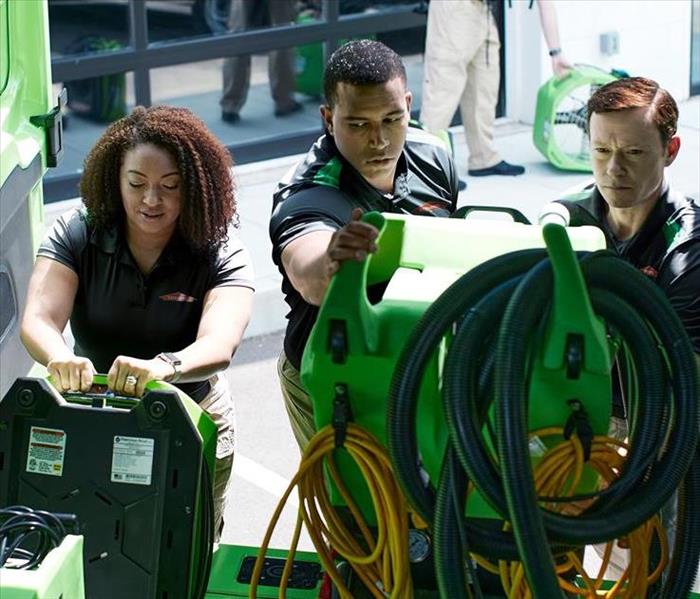 Our teams are ready to help with your disaster 24/7
Our teams are ready to help with your disaster 24/7
Water damage is one of the most costly disasters your home or business can experience. The Insurance Information Institute estimates that billions are spent on water damage each year. View these suggestions from SERVPRO of Hurst-Euless-Bedford for preventing water damage.
Be careful where you plant.
Some plants and trees, like weeping willows, have pretty invasive roots. If you’re not careful, they’ll grow right into your sprinkler system, drainage field, pipes, and septic tanks. Plan before you plant to keep roots away from any water lines.
Clean out roof gutters.
On a rainy day, a clogged gutter can send water spilling into your home’s foundation, through the roof, or down to your basement. That could cause some severe water damage So next time you’re doing some seasonal cleaning, make sure those gutters are clean. If your gutters are too high, be safe, and get a professional to check them.
Use a drain snake instead of unclogging chemicals.
Most folks don’t realize these chemicals are eating away at their pipes (and they might not be too good for you either). If you rely on them a lot, you could be setting yourself up for leaks. That’s why owning a drain snake is an excellent solution to clear away clogs. They’re pretty inexpensive, you can get them at your local hardware store, and they can cut through most any clog you’ll have without damaging pipes or making your eyes red and teary.
Never pour grease down your sink.
It doesn’t matter if you flush it with hot or cold water; grease can still cling to your pipes and could even cause some severe damage and blockage. The safest thing to do is pour your grease into an empty can and either let it sit or put it in the refrigerator. Once it hardens, you can toss it in the trash and get rid of it. Done and done. However, we know that water and flooding emergencies can happen any time, so we’re ready 24 hours a day, 7 days a week – including holidays. Contact us at (817) 595-0004.
SERVPRO: Which appliances can lead to water damage at homes?
1/27/2022 (Permalink)
Blog summary: The SERVPRO blog gives insight into the various appliances that can cause water damage if not maintained regularly.
Appliance failures that lead to water damage
With appliance failures accounting for 30% of residential flood claims, homeowners must understand how this water damage occurs. SERVPRO talks about those common culprits in the blog below so homeowners can prevent the potential water damage.
One of the top five sources of water damage, water heaters must be inspected annually for signs of corrosion and other factors as the heater ages. The main causes of a water heater malfunction or failure are mineral deposits, thermal expansion, anode rod damage, and an incorrect-sized water heater. It has also been observed that 69% of water heater failures are due to leaks or bursts which can cause up to $4444 in damage. Ideally, water heaters must be replaced every 10 years to prevent such mishaps.
With an average damage of $5000, water damage caused by air conditioners can be drastic and expensive. Replacing drain pans with drain pipes that have an outlet outside or to a household sewer can help check the water overflow in air conditioners. If there is an air conditioner in the attic, homeowners must keep an eye on it for any potential water leaks as any leak in this area is sure to permeate into the complete house. The damage costs, in that case, may prove to be phenomenal.
Almost 78 percent of washing machine failures occur in an appliance that is less than 11 years old. Homeowners must regularly inspect the hoses to catch any cracking, dryness, or rust before it leads to any water leaks. There must be adequate space between the machine and the wall for movement during the wash cycle. Hoses must be replaced every five years and all washing machine instructions must be followed to the tee.
A defrost drain that is frozen or clogged is the usual cause of refrigerator leaks. Homeowners must thaw the ice and flush the drain with hot water. Another cause of leaks is a damaged or broken hose in the back of the refrigerator that connects the home’s water supply to the ice maker or water dispenser. Check for improper sealing due to ineffective rubber seals along the door, which can lead to excessive condensation to keep the refrigerator cool.
From hoses and valves to switches, there are various plumbing connections that can cause the puddle of water below a dishwasher. Overfilling a dishwasher, adding too much detergent to a cycle, and failing to do a routine inspection of water inlet valves and float switches is a recipe for a water disaster. Moreover, a dishwasher older than 9 years should be replaced to avoid extensive water damage.
Homeowners who are seeking water damage repair can contact a professional water damage restoration company like SERVPRO to help them restore their property at the earliest possible.
Why SERVPRO?
- SERVPRO uses state-of-the-art equipment to bring the damaged property back to its original state. SERVPRO of Hurst-Euless-Bedford is always updating its fleet and equipment so clients in Hurst, Euless, Bedford, or anywhere else can quickly access the services.
- With over 1,700 US and Canadian Franchise locations, SERVPRO is strategically positioned to respond faster to an emergency of any magnitude.
- The SERVPRO staff is highly trained in property damage restoration. They receive initial in-house training and constant skill up-gradation at the corporate training facility and also acquire the regular IICRC-industry certification.
For water damage restoration services, contact Team Shaw of SERVPRO of Hurst-Euless-Bedford today at (817) 595-0004 or e-mail at office@SERVPROheb.com
Simple tricks to avoid frozen pipes and winter water damage
12/21/2021 (Permalink)
Blog summary: The SERVPRO blog gives insight into the various causes of frozen pipes and ways to prevent the damage they may cause.
Tips to prevent frozen pipes and winter water damage
Come winters, the plunging temperatures often cause the pipes to freeze and disrupt the plumbing system, eventually leading to the bursting of pipes and enormous water damage. But this damage can be prevented by following some simple steps as shared by SERVPRO of Hurst-Euless-Bedford in the blog below.
What causes pipes to burst?
At a temperature of 32 degrees Fahrenheit, water expands, and its density decreases. This expansion creates immense pressure on its container, anywhere between 50,2000 and 114,000 psi. Irrespective of the material of the container, this tremendous pressure will cause it to burst. Pipes in exterior walls, crawl spaces, or outdoor faucets are especially prone to bursting when exposed to cold temperatures for any length of time. The consequent water damage and its repair costs can be prevented by following some basic preventive measures.
Several factors lead to frozen pipes such as:
- The type of building construction
- The quality and quantity of insulation
- The decline in temperature
- The direction and force of the wind
- Other weather-related conditions
Moreover, buildings with a poor design are unable to withstand severe weather sufficiently and can contribute to their damage. Rusted or corroded pipes make leaks more likely.
Pipe freezing can also be a particular problem in the warmer climates of southern states where buildings are not built to tolerate cold weather conditions. Damage occurs when the water supply is turned back on and the weakened pipes burst open.
During power outages, the pipes are likely to freeze as most of the heating systems are dependent on electricity.
Preventive measures
Property owners must deduce which pipes are a priority when inspecting and protecting pipes from freezing. As a general rule, exposed pipes in parts of a home without heat, pipes in exterior walls, and any plumbing or pipes on the exterior facing side of the home must be treated as a priority.
If the flow of water in faucets slows to a trickle during a cold snap, or if the property owners suspect that the pipes are vulnerable, action is necessary. Here are some preventive measures to make sure pipes don’t freeze:
- Insulate the pipes
Adequate insulation in the house, especially along exterior walls and in crawl spaces is crucial. Adding more insulation in the walls, attic, or along the overhanging eaves of a home is an inexpensive way to prevent water damage associated with pipe bursts. Insulate both hot and cold water pipes in these areas with a “pipe sleeve” or install UL-listed heat tape, heat cable, or similar materials.
- Keep the heat on
In the property owner’s absence, the thermostat should be set to somewhere around 55 degrees to prevent frozen pipes. However, it must be noted that the existing water in the pipes may still freeze during severe cold snaps. Draining the plumbing system thoroughly with compressed air to blow out the lines can ensure low spots are also devoid of water.
Additionally, open kitchen and bathroom cabinet doors to allow warmer air to circulate the plumbing.
- Let the faucet drip
A tiny trickle from faucets works like a charm. It reduces the pressure in the pipes and the constant flow of water through the pipes makes the freezing highly unlikely.
- Thaw carefully
- Identify the frozen pipes: If there is no water flow when a faucet is turned on, the likelihood of frozen pipes is high. Inspect under the sink to look for frost on the pipes or bulges in the waterline.
- Switch on the faucet: Turn on the faucet to keep the water flowing and prevent pipe freeze by relieving the water pressure. Both cold and hot water must be turned on full throttle during the thawing of pipes.
- Apply heat at the faucet: Pipes that have been identified as frozen can be thawed by applying gentle heat to the faucet with a hairdryer, small ceramic space heater, hot towels, or even electric heating cables. Heat must be applied until the full water pressure is restored.
- Call a plumber
Any existing cracks in the pipe must be addressed by a plumber immediately. This is imperative to prevent any further water damage and mold growth.
Why SERVPRO?
- SERVPRO uses state-of-the-art equipment to bring the damaged property back to its original state. SERVPRO of Hurst-Euless-Bedford is always updating its fleet and equipment so clients in Hurst, Euless, Bedford, or anywhere else can quickly access the services.
- With over 1,700 US and Canadian Franchise locations, SERVPRO is strategically positioned to respond faster to an emergency of any magnitude.
- The SERVPRO staff is highly trained in property damage restoration. They receive initial in-house training and constant skill up-gradation at the corporate training facility and also acquire the regular IICRC-industry certification.
For water damage restoration services, call SERVPRO of Hurst-Euless-Bedford today at (817) 595-0004 or e-mail at office@SERVPROheb.com
Water damage that a DIY pressure washing project can cause to a home
11/29/2021 (Permalink)
Blog Summary: The SERVPRO blog gives insight into the possible water damage disaster that a DIY pressure washing can cause to a home.
The cons of a DIY pressure washing project
Dirt, grime, and oil stains can make a home look unappealing. Curb appeal can be enhanced by pressure washing the house, walkways, patios, roofs, and the driveway. However, a pressure washing DIY project by a homeowner can cause some serious water damage to a house. SERVPRO shares some of the ways such a project could prove to be expensive for a homeowner.
Pressure washing requires special equipment that launches a fine stream of water at 1500 psi to 3300 psi. Without appropriate knowledge of the surfaces being cleaned and the appropriate cleaning chemicals, this high-pressure water stream with its approximate speed of 250 mph can severely damage a home.
- Cracked or shattered windows
High water pressure can crack or shatter a windowpane upon contact while the suds and spray from the pressure washing wand may conceal the damage, resulting in large amounts of water being sprayed inside a house. Not only does this cause extensive water damage but the broken glass pieces can lead to serious injuries during cleanup. A DIY pressure wash gone wrong can raise the overall losses to a property owner. Not only will damaged window panes need to be repaired by a professional glazier but a pressure wash on a replacement window can render the warranty null and void.
- Leaking and rotting of window seals
The force of the pressure wash can instantly damage or completely dislodge window caulking. This will allow rainwater and further washing to seep into the window seals and cause extensive damage such as rotting wood, blistering paint, and mold between walls. This damage may get noticed by homeowners much later when things are already out of hand. Homeowners would need to get the damage inspected by a water damage expert. It is possible that the extent of the damage warrants not just drying and caulking but demolition and rebuilding services as well.
- Dislodged shingle and roof leaks
Pressure washing the roof can strip the shingles off the roof and give way to water leaks from the pressure washing and any other forms of precipitation into the attic. Even with a minor water intrusion, the attic with its lack of air circulation and tendency to retain moisture becomes a perfect environment for mold growth. Unaddressed, the water leak can cause wooden structural beams to disintegrate, diminish the insulating capacity of attic insulation, and damage the ceilings. This entails a huge amount of restoration costs for the property owners.
- Damaged fascia and dislodged gutters
Fascia damaged by pressure washing may not support gutters properly, further exposing the fascia to more moisture and rot. Damaged gutters that do not direct the water away from the foundation may allow moisture to seep into the crawl spaces, leading to wood rot of mold infestation. Moreover, the fascia may leak water into the eaves of the home.
- Permeable wood siding
High-pressure washing can penetrate the wood siding of a home and seep into the interior walls. The moisture in the dark, warm interiors of the house will inevitably lead to wood rot, mold infestation, wall stains, bubbling paint and wallpaper, warped sheetrock, and an unmistakable musty odor. By the time the signs of the damage become evident, the damage may be too extensive and would require the services of a professional water damage restoration and mold remediation service.
Why SERVPRO?
- SERVPRO uses state-of-the-art equipment to bring the damaged property back to its original state. SERVPRO of Hurst-Euless-Bedford is always updating its fleet and equipment so clients in Hurst, Euless, Bedford, or anywhere else can quickly access the services.
- With over 1,700 US and Canadian Franchise locations, SERVPRO is strategically positioned to respond faster to an emergency of any magnitude.
- The SERVPRO staff is highly trained in property damage restoration. They receive initial in-house training and constant skill up-gradation at the corporate training facility and also acquire the regular IICRC-industry certification.
For water damage restoration services, call SERVPRO of Hurst-Euless-Bedford today at (817) 595-0004 or e-mail at office@SERVPROheb.com
How to tell if your flooring has had water damage
10/12/2021 (Permalink)
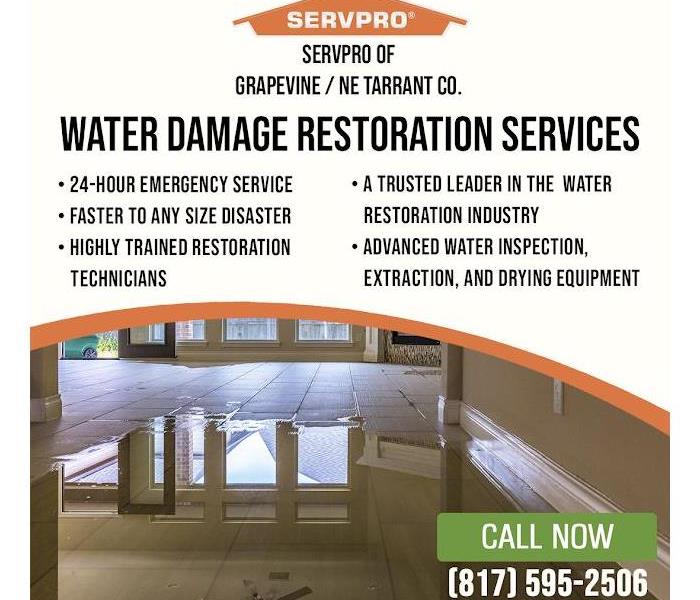 Standing Water Damage on Floor - Call us if you need assistance!
Standing Water Damage on Floor - Call us if you need assistance!
Kind of like an expensive car isn’t protected from hail damage or dings in a parking lot even the most expensive floors aren’t protected from water damage. It can unfortunately destroy any type. Thankfully, there are signs. Here’s what to look out for just in case you suspect water damage to your flooring.
Carpet: If It’s smelly or discolored then it’s most likely got mold or mildew.
Laminate: Keep an eye out for any swelling, discoloration, or warping.
Tile: If you tap on the tiles with a coin and hear a hollow sound, it may mean the tiles have come loose. Cracking is another good sign.
Linoleum: Look for discoloration.
Hardwood: The easiest of all the flooring besides carpet to tell if your home has water damage! Keep an eye out for dark spots that have mysteriously popped up recently, it could be mold or mildew. If your floor has started to cup or buckle, then it could mean water has gotten under and the planks of your floor have come loose due to water damage. And lastly, look for bulging or bubbling too your floor.
If you suspect your floor has had water damage, give SERVPRO of Hurst-Euless-Bedford a call today!
SERVPRO suggests precautions that homeowners can take to prevent basement flooding
8/25/2021 (Permalink)
Blog summary: SERVPRO explains several steps homeowners can take to protect their basement from flooding and water damage.
7 tips to prevent basement flooding
A flooded basement entails massive expenses for water mitigation and restoration services. The best practice is to prevent basement flooding by taking proactive measures and containing the extent of the water damage. SERVPRO shares important tips that can help prevent basement flooding.
Homeowners must check the gutters once in spring and in autumn for natural debris such as twigs and leaves. A blocked gutter leads to the pooling of water on the siding and perimeter of the house when rains occur. This water then enters the basement through cracks and faults in the foundation.
- The downspout must direct the water at least 6 to 12 feet away from the home. The water should drain downwards and away from the home foundations.
- Installing metal downspout extensions is recommended as they do not leak and are more durable than the plastic ones.
- If the yard has space for add-on extensions, installing underground PVC drain pipes can direct water to the front or back yards. Ensure the pipes do not flood the neighbors’ basements.
Grading the lawn to slope away from the house or installing french drains can ensure that the water doesn’t leak into the basement. This grading prevents the water from pooling around the house’s perimeter. Homeowners can create a dry creek around the house and splice the lawn in a way that directs all excess water into the creek. Moreover, a porous pavement around the house can help absorb rainwater and thawing snow.
Moisture and humidity in a basement is inevitable due to its proximity to earth and the limited ventilation. Running a dehumidifier 24 hours a day, especially from April through October, can address this dampness. The dehumidifier will dry the condensation that appears on the foundation walls in summer.
Minor, vertical cracks are a normal occurrence in concrete foundations, especially in a new home. Hairline faults can be sealed with an epoxy sealant or polyurethane foam injection. However, persistent cracks must be taken seriously and should be addressed by a professional contractor.
Floods caused by storms can cause serious water damage to a home. It is crucial for homeowners to maintain their sump pump in case of a flooding situation. Moreover, power outages are common during and after storms. Therefore, a sump pump with a 120-volt backup battery and a check valve can be a blessing during this crisis. The pump should drain outside and far away from the home perimeter.
Below-grade basement windows without the protection of window well covers allow rain and natural debris to enter the basement. Clear, acrylic covers successfully keep the basement dry while allowing in sufficient light.
However, poorly installed window well covers, inadequate drainage, and incorrect window well size can defeat the purpose of a window well cover.
Most homeowners’ insurance policies do not cover basement flooding. But flood insurance should be purchased separately from the National Flood Insurance Program, especially by homeowners who reside in high-risk flood areas. Review the insurance policy for coverage related to basement flooding.
Why SERVPRO?
- SERVPRO uses state-of-the-art equipment to bring the damaged property back to its original state. SERVPRO of Hurst-Euless-Bedford is always updating its fleet and equipment so clients in Hurst, Euless, Bedford, or anywhere else can quickly access the services.
- With over 1,700 US and Canadian Franchise locations, SERVPRO is strategically positioned to respond faster to an emergency of any magnitude.
- The SERVPRO staff is highly trained in property damage restoration. They receive initial in-house training and constant skill-up-gradation at the corporate training facility and also acquire the regular IICRC-industry certification.
For water damage restoration services, call SERVPRO® of Hurst-Euless-Bedford today at (817) 595-0004 or e-mail at office@SERVPROheb.com
SERVPRO shares 10 Steps Property Owners Can Take to Prevent Plumbing Leaks
6/17/2021 (Permalink)
Blog summary: This article by SERVPRO dives into the various preventive measures that businesses and homeowners can follow to prevent damage caused by plumbing leaks.
10 Tips to Prevent Plumbing Leaks
A plumbing system consists of much more than just the visible components – the sinks, faucets, water heaters, and drain pipes. An extensive network of supply and drain pipes is usually running within walls or floors or buried underground, hidden from the view.
A poorly maintained or neglected plumbing system in a commercial building or a home can lead to major leaks causing expensive water damage.
SERVPRO of Hurst-Euless-Bedford shares the common causes of plumbing leaks and the various measures business owners and homeowners can take to prevent them.
The common plumbing leak culprits are:
- Dishwashers
- Icemakers
- Water heaters
- Toilets
- Sinks
- Washing machines
- Showers and tubs
10 Preventive Steps
Reduce water pressure
As per experts, high water pressure simply reduces the life of plumbing as it stresses the pipe joints, faucets, and appliance valves. Water pressure can be measured with a hose bib gauge and should lie within 40-85 psi, normally. Anything above this range will put immense pressure on the plumbing and eventually give way to leaks.
- Soften the water
A high mineral content in water, known as hard water, slowly builds up minerals such as magnesium and calcium in the pipes. This leads to restriction of water flow, corrosion of joints and fittings, and increasing pressure.
Installing a water softener is the best method to combat hard water. Most softeners use sodium to counteract the minerals in the water, but there are electronic softeners that use only electromagnetic pulses to dissolve minerals.
Insulate the pipes
Pipes that are exposed to freezing temperatures or drafts can freeze and leak. It is advisable to insulate all exposed plumbing that is accessible and seal any external openings that allow frigid air to contact water supply lines. When temperatures drop below 25 degrees, the household thermostat should be set at 55 degrees or higher and taps should be left slightly open to allow water to dribble out as long as freezing temperatures persist.
Replace washing machine hoses
A leaky or ruptured washing machine hose is a common cause of leaks. Rubber hoses that supply water to washing machines have a lifespan of five years only. Therefore it is a good measure to replace rubber hoses before they leak and use braided stainless steel lines that are much more durable.
- Do not ignore minor leaks
Leakage of any magnitude is not normal. It is advised to do a visual inspection of all faucets, toilets, and exposed pipes as well as any signs of leaks where the pipes penetrate the walls or foundation. Small pools of water on the floor, water stains near the pipes, or warping of wallboard or paneling could indicate the presence of a leak.
All plumbing fixtures should be solidly attached to the floor or wall as the seals can break pipe connections. Even a pinhole in supply lines is a sign of internal corrosion that is a warning of the imminent bursting of pipes and severe flooding. These signs must be addressed immediately by a water damage restoration company.
- Test all shutoff valves
The location of the main water shutoff valve and how to operate it in emergencies must be common knowledge. Since valves often freeze in the open position due to the accumulation of mineral deposits, it is a good practice to test the main valve yearly to ensure it turns off and on easily. All individual shutoff valves such as those installed on the wall behind toilets and under sinks must also be tested.
- Inspect the drainage function
Water should travel easily down the drain pipes while creating a familiar swirl pattern as it enters the pipes. The appearance of bubbles or a gurgling sound during drainage could indicate a problem that needs to be corrected.
- Install floor pans
Floor pans under appliances are the first line of defense against water leakage. They cannot prevent catastrophic leaks but can prevent water damage from minor and slow leaks.
- Get a water alarm
Water alarms alert the inhabitants of a water threat. These sensors can be placed in basements, laundry rooms, bathrooms, kitchens, or next to the sump pump.
- Purchase a water flow monitoring system
A water flow monitoring system is protection for the complete property. It is attached to the water main and measures the water flow into the premises. In case of continuous water flow that is over and above the normal usage, the system will stop the flow of water automatically.
In case of water damage caused by plumbing leaks, property owners can get in touch with water damage restoration companies like SERVPRO of Hurst-Euless-Bedford.
Why SERVPRO?
- SERVPRO uses state-of-the-art equipment to bring the damaged property back to its original state. SERVPRO of Hurst-Euless-Bedford is always updating its fleet and equipment so clients in Hurst, Euless, Bedford, or anywhere else can quickly access the services.
- With over 1,700 US and Canadian Franchise locations, SERVPRO is strategically positioned to respond faster to an emergency of any magnitude.
- The SERVPRO staff is highly trained in property damage restoration. They receive initial in-house training and constant skill up-gradation at the corporate training facility and also acquire the regular IICRC-industry certification.
For water damage restoration services, call SERVPRO® of Hurst-Euless-Bedford today at (817) 595-0004 or e-mail at office@SERVPROheb.com
4 Facts About the Power of Saltwater Damage Restoration
4/20/2021 (Permalink)
Blog Summary: The SERVPRO professionals discuss four saltwater damage facts, explaining how saltwater affects water damage restoration for the residents and business owners of Hurst, Euless, and Bedford, TX.
Texas has some of the most beautiful beaches in the Gulf, but all that salt in the air means that the region’s home and business owners are bound to need water damage restoration services at some point. The humidity in the coastal areas can be as overwhelming as the summer heat, and the chances are good that visitors will see water or fire restoration companies rushing to an emergency service during extreme weather.
SERVPRO of Hurst-Euless-Bedford, TX is one of the area’s premier residential and commercial water damage restoration companies. Their experts offer advice on dealing with salt, humidity, and water restoration companies in the area.
Four Saltwater Facts and How It Affects Water Damage Restoration
#1: Saltwater Damages Far Exceed Rainwater Issues
The high salt content in saltwater is considerably more destructive than regular rainwater. A home or business can have a professional service dry surfaces contaminated by rainwater. If the surface isn’t delicate and the absorption is minimal, this may often be the end of the story.
However, saltwater pooling on surfaces sees much more damage. It is extremely corrosive, even when a surface dries off completely. The salt residue continues to eat away at the material beneath—the only way to stop the process is to call water damage restoration experts like SERVPRO who understand residue and flood cleanup.
#2: Salt Water and Electricity—A Terrible Combination
Salt is an excellent conductor of electrical currents. While a home is under saltwater, the water itself can carry a dangerous charge. After the flooding has subsided, salt residue also conducts electricity outside protective features, like electrical fixtures designed to keep people safe.
The salt residue corrosion also eats through wire cladding on dried-out electrical components, exposing the wiring and causing unexpected short circuits. If there’s a chance that a home or business has a bad combination of salt and electricity, it is best to call a professional water and fire damage restoration service like SERVPRO to handle it safely.
One benefit of SERVPRO’S extensive national network is the 24-hour emergency services and professional building restoration service options, no matter the location. They also offer an air duct cleaning service to sweep the HVAC systems after extensive water damage restoration or electricity issues.
#3: Salt Encourages Extensive Mold Growth
When a building has flooded, damp items tend to play host to unhealthy organic material. However, when floodwaters contain salt, the mold grows even quicker, and it is far more difficult to eradicate. It is important to protect people’s health, and mold removal or mold remediation companies like SERVPRO offer this service as part of water damage restoration.
The highly-trained technicians have honed skills over many years, and the professional service might be the only way to prevent the vigorous mold growth common to saltwater-damaged buildings.
#4: Salt Destabilizes the Property’s Foundations
All major floods carry the danger of soil erosion, but saltwater alters the entire chemical makeup of the soil. It kills plants that aren’t adaptable and destabilizes the structure as the soil shifts and displaces other components. Water removal from around a house or office building is a priority, but this applies even more to saltwater issues.
Getting rid of the salt residue is the only way to restore the soil and structural integrity. It is a good idea to call in the services of building restoration companies, like SERVPRO. These teams are locally owned and operated, and they know how to handle extensive saltwater damage without compromising the environment around the property.
SERVPRO of Hurst-Euless-Bedford, Texas, is a premier water damage restoration service that performs quick water cleanup and saltwater removal. The team eradicates salt contamination from all surfaces and offers many other tips and services on their Facebook page. Contact SERVPRO’s professionals at (817) 595-0004 or visit the offices at 3717 Commerce Place Suite E, Bedford, TX 76021.
Why FAST Response is Crucial for Water Damage Restoration
3/8/2021 (Permalink)
Blog Summary: SERVPRO of Hurst-Euless-Bedford offers unique solutions custom-tailored for each water damage restoration case in and around Bedford, TX.
The first 24 to 48 hours are crucial for preventing permanent damage when water is involved. Any longer and the risks of microbial growth such as mold and bacteria increase dramatically. Thankfully, the highly trained water damage specialists at SERVPRO of Hurst-Euless-Bedford can quickly help with water damage restoration services.
Water Damage Restoration: Why is FAST Response Important?
Each day over 14,000 Americans face a water damage emergency. Whether it is from flooding or a broken pipe, a water-damaged home is at risk for further damage in the form of mold, rot, and bacteria. The longer the water exposure, the greater the damage becomes. That is why the first 24 to 48 hours after a home suffers water damage is critical.
Trained professionals, such as those as SERVPRO of Hurst-Euless-Bedford, offer 24-hour emergency service and are equipped with advanced inspection, extraction, and drying equipment for fast water removal and cleanup.
Water restoration companies remove water quickly and efficiently, including hidden moisture, then dry structures with powerful dehumidifiers. Once complete, they sanitize the entire area to protect it against pathogens and bacteria.
The sooner water damage remediation begins, the greater the success of the process. Choose a water restoration company with 24-hour service and on-site support staff that can get someone out to assess and clean up the water damage as soon as possible.
What To Do Before Water Damage Restoration Professionals Arrive
As soon as water damage occurs, several steps can help mitigate further damage and prepare for professionals' arrival.
- Stop the water. If possible and safe, stop water flow by closing the valve on the water supply. Preventing additional water exposure can save hundreds of dollars in flood cleanup and water damage restoration services.
- Assess the damage. Check for immediate threats like electricity exposure or dark water. Make sure not to come in contact with the water, and do not attempt any do-it-yourself approach to handling the situation. Let the professionals at SERVPRO of Hurst-Euless-Bedford take care of the water removal and water cleanup process.
- Take pictures. Make sure to document the damage for insurance purposes by taking photos of the affected areas. Do not throw anything out without taking a picture first.
- Call a water damage restoration service. At this point, it is time to call the professionals to clean up, dry out, and restore all water-damaged areas of the home. SERVPRO of Hurst-Euless-Bedford offers fast and convenient 24-hour service to residents of Bedford, TX, and the surrounding areas.
When it comes to water damage, always practice safety first. If there is any doubt about whether a water-damaged area is safe, call a professional to take care of everything properly. If there is water near electrical wires or outlets, a sewer line has backed up, or any visible mold forms from the damage, stay clear of the area.
Professional Water Damage Restoration in Bedford
For water cleanup, water removal, flood cleanup, or any other services related to water damage, including filing insurance paperwork, give SERVPRO of Hurst-Euless-Bedford a call at (817) 595-0004 or request help online. Their water damage repair and restoration services are available 24/7, and their equipment can handle any size disaster quickly.
Contact Information:
SERVPRO of Hurst-Euless-Bedford
3717 Commerce Place Suite E
Bedford, TX 76021
www.SERVPROhurst-euless-bedford.com/
4 Tips on Water Damage Restoration and Insurance Claims
2/23/2021 (Permalink)
Blog Summary: Learn more about the water damage restoration and insurance claims process, from assessment to avoiding denials, with these simple tips from the restoration pros at SERVPRO of Hurst - Euless - Bedford, TX.
Water damage is one of the most common insurance claim types—even more so in recent years, with claims becoming more severe and frequent.
Currently, approximately one in 50 property owners file a water damage claim each year. The average claim comes in at around $10,000, leading insurance companies to pay about $13 billion annually in claims.
Since 2015, the number of water-related claims exceeding $500,000 has doubled annually, and those exceeding $1 million have nearly tripled. This escalation is mainly due to an increase in intense storms, aging homes, and insufficient plumbing maintenance.
When a water disaster strikes, it's essential to have a professional water damage restoration company on your side. It also helps to understand the restoration and insurance claim process. The experts at SERVPRO of Hurst - Euless - Bedford, Texas, are here to share some tips on dealing with water damage restoration and insurance claims.
#1: Assess Water Damage
Regardless of whether the loss experienced was a significant flood or slow leak, any type of water damage must be taken seriously. Water can quickly destroy property and create health hazards like mold. It's essential to move fast on water removal and repair. Make sure to take photos of the water damage to submit to the insurance company.
#2: Call a Water Damage Restoration Pro
Although a homeowner’s first instinct might be to call the insurance company, it’s best to contact a water damage restoration company like SERVPRO of Hurst - Euless - Bedford, first. The experts at SERVPRO are available 24/7 to respond to any crisis. They will quickly assess the water damage and give advice on how to deal with an insurance claim.
Once SERVPRO is hired to perform water damage restoration services, they’ll take over the project. Water damage restoration and mold remediation companies like SERVPRO perform the following services:
- Gather evidence of damage and estimates for repair
- Secure the property to prevent additional damage
- Deal directly with the insurance adjuster
- Negotiate with the insurance company for a payout
- Handle water removal, mold removal, and flood cleanup
- Provide fire damage restoration services
- Offer air duct cleaning services
- Sanitize and thoroughly dry property
- Restore and rebuild damaged property
#3: Contact the Insurance Company
Insurance policies are complex and confusing. It can be hard to determine what is covered under the policy. Although property insurance policies vary greatly, most cover sudden and accidental water damage. Here are some types of water damage not typically covered by standard insurance:
- Water damage resulting from poor maintenance of pipes or appliances
- Water or sewage backup from an outside sewer
- Flooding from storms or overflowing bodies of water
#4: Avoid Insurance Claims Denials
The insurance company may deny a claim for many reasons. The best way to avoid a deny is to prepare before a disaster strikes:
- Collect records of home repairs and appliance maintenance
- Carefully review your insurance policy and make sure it covers common causes of water damage
- Keep up on routine maintenance for the home and appliances
Need Help with Water Damage Restoration?
SERVPRO can help navigate the insurance claims process. They offer residential and commercial water damage restoration throughout the Bedford area. SERVPRO is also one of Texas’ leading fire restoration companies with dozens of 5-star reviews from satisfied customers. If you need water cleanup or mold removal, contact SERVPRO today.
Contact Information:
SERVPRO of Hurst-Euless-Bedford
P: (817) 595-0004
3717 Commerce Place Suite E
Bedford, TX 76021
https://www.SERVPROhurst-euless-bedford.com/
Commercial vs. Residential Water Damages
10/9/2020 (Permalink)
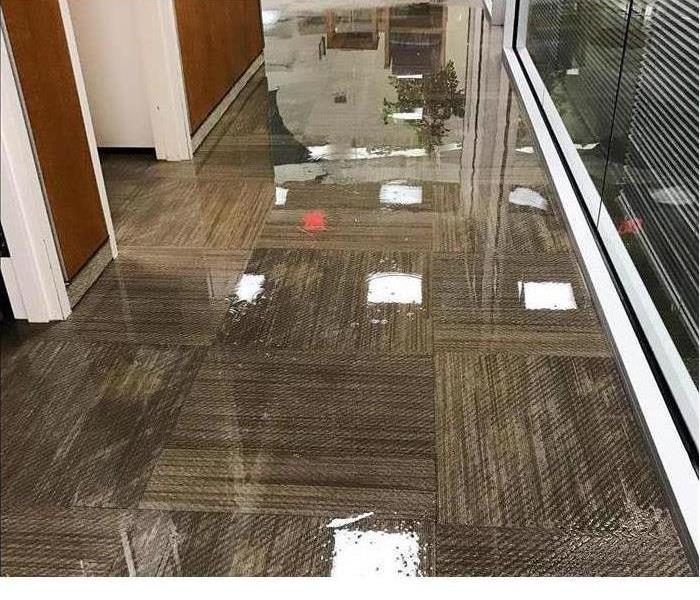 Standing water in a commercial office building
Standing water in a commercial office building
As we move into the colder, wetter months, we all have to consider the possible damages that our structures can sustain during this time of year. Summer’s storms are past, and now from leaky roofs and moldy siding to deep ruts in the driveway or potholes in the parking lot, the fall and winter months will bring their own set of concerns to both home and business owners. Weather won’t be as violent, but rains can last a lot longer, and then will come sleet, ice, and snow.
For the homeowner, some of the exterior concerns due to weather will be:
- Eroded landscaping
- Rutted driveways, especially those that are graded either up or downhill
- Moldy siding, window sills, door-jambs, window panes, and roofing
- Rotting wooden fencing and decking
- Leaking roof
- Puddles and pooling
For the business owner, some of the exterior trouble spots can be:
- Potholes and eroded surfaces in public parking areas
- Eroded walkways or damaged, buckling sidewalks and public walkways
- Leaking roofs
- Damaged materials and machinery that have not been stored properly
When it comes to the interior spaces, businesses have to keep an eye on employee bathrooms and kitchen/break areas to make sure that leaks are handled immediately and that spills are cleaned up right away. During bad weather, customers and vendors will track water and debris into your building, and both for safety and aesthetics, it will be a good idea to keep up with this type of accumulation to prevent water damage. Have an umbrella stand ready for everyone who comes through the door!
Homeowners also need to keep up with spills, leaks, and traffic, but it will obviously not be such a large job. In a home, water damage is more likely to come from a water heater or dishwasher that is malfunctioning, or a washer that has developed an issue.
One thing both types of structures have to be concerned about is mold, however - it is never a good thing to realize that a colony has taken hold in either your home or your business.
The team at SERVPRO of Hurst-Euless-Bedford is experienced in all types of clean up after water damage to both homes and businesses, and mold remediation is one of our specialties. Call us today at (817) 595-0004!
Dealing With Water Damage in your Attic
10/2/2020 (Permalink)
Considering the attic isn’t an area that is used often by homeowners, it’s easy to forget about it. This is the main reason water damage in the attic often goes unnoticed. If water damage isn’t addressed, it can cause more damage to the areas below the attic and potentially cause mold. The signs of water damage usually include water stains, mold, or musty odors in your home. It is important to make sure you take the proper steps to assess the damage as soon as you notice in order to assure your safety and health, and avoid expensive repairs.
In order to address the damage, you must first find the source of the problem. Begin by evaluating the damage. Where is the water coming from? Could it be a burst pipe or a hole in your roof? Make sure to check the roof for leaks on a regular basis. The water damage in your attic can also be caused by a lack of ventilation. Humidity can get trapped in the attic and cause a buildup of condensation, which causes water damage. Be sure to remain safe throughout this process and turn off all electrical items before touching anything.
The next step is to inspect for mold and fix any leaks. As previously mentioned, water damage can lead to a more serious issue, mold, and mildew. Mold can grow in as little as 24 hours, and it’s easy for it to go unnoticed. When inspecting for mold, it is important to take the proper precautions and be careful. Some mold is toxic to humans and if the mold is a serious issue rather than a small one, it’s best to contact a professional. It is also advised to contact a professional before attempting to fix any leaks unless you have to tools and skills to do so with ease.
SERVPRO of Hurst-Euless-Bedford is always ready to help and assist you with any water damage or mold you may have! If you’re in over your head with water damage, give us a call at (817) 595-0004.
Top Three Spots to Check for Water Damage in your North Texas Home
9/25/2020 (Permalink)
Catching water damage before it becomes evident can save you time and money, so knowing the top spots in your home to regularly monitor for damage is crucial for any homeowner. Instead of waiting until a water stain appears on your ceiling or water pools on the floor under your sink, make it a priority to inspect these three spots for water damage on a monthly basis.
- Check under the sink.
Sinks are regularly located in your kitchen, your bathrooms, and maybe even in other rooms in your house. Since water flows from the faucets and comes up through pipes underneath the sink, it’s not uncommon for leaky sinks to occur. Always inspect the cabinetry and piping underneath your sink for any leaks or moisture.
- Don’t forget to look behind the toilet.
Your toilet is another frequently-used appliance in your home that uses a lot of water with every flush. Monitoring the space behind and around your toilet for any water damage is always a good practice.
- Take a look at your roof.
It’s easy to forget to look at your roof for water damage, but if your gutters aren’t working properly or your roof isn’t in good shape, there’s a fair chance that water may be seeping through your roof into your attic, your garage, and your ceilings. It can be hard to know what to look for, but any obvious water stains are a bad sign. Be sure to check out the roof from the exterior and the interior sides (your ceilings).
Water damage can be costly and affect the structural integrity of your home, and so it’s important to keep an eye out for water damage before it wreaks havoc. If you’re looking to buy a new home, here are a few things to look for to ensure that you don’t prematurely buy a home that’s susceptible to water damage.
If you recognize the signs of water damage on one of your regular rounds inspecting the vulnerable areas of your home, contact SERVPRO of Hurst-Euless-Bedford at 817-595-0004. With state-of-the-art technology and training, our disaster restoration professionals are equipped for handling the job.
Water Damage Restoration Protocol Steps
7/24/2020 (Permalink)
Water and mold damage can be very destructive to your home or business. The most important thing to remember in case of a flood is to act quickly. First, call your insurance company to see if the damage is covered. Most insurance agents or adjusters will recommend a reputable and approved restoration company to do the clean-up. Find out if you have a deductible and know what it is. If you do not have insurance the first thing you must do is dry out your basement.
If water is left longer than 48-hours, it can be considered hazardous and the cleanup process can turn into a much bigger expense.
The following clean up steps are the proper protocol:
- Extract the water and find the source of the problem.
- Remove any contaminated materials including carpet, drywall, boxes, and anything else that might have gotten wet. The level of saturation in the amount of time and materials were exposed to the water will determine if the items are salvageable.
- Place air-movers and dehumidification equipment throughout the flooded area. Keep them on until the basement and crawl space is thoroughly dry. This may take 3-5 days.
- Do not replace or remove any of the unsalvageable materials until your insurance adjuster has deemed them unsalvageable. Make sure all your items are free of mold before moving them to a dry area of the home.
If you find mold in your basement or crawlspace or there are signs in your house like a musty smell, you may need to have the air tested. This test should be conducted by a certified inspector and sent to an accredited lab for analysis.
If you have a water or flood damage to your home or business, SERVPRO of Hurst-Euless-Bedford has emergency services 24 hours a day – 7 days a week! Our crews are highly trained to remove the damaged materials and begin the restoration process using specialized equipment to determine the wet areas, extracting any standing water and placing fans and dehumidifiers to remove all excess moisture to restore your home to “Like it never even happened."
Call SERVPRO of HEB, your local water restoration and cleanup company at 817-595-0004.
TIPS on avoiding chaos from SERVPRO employees
6/8/2020 (Permalink)
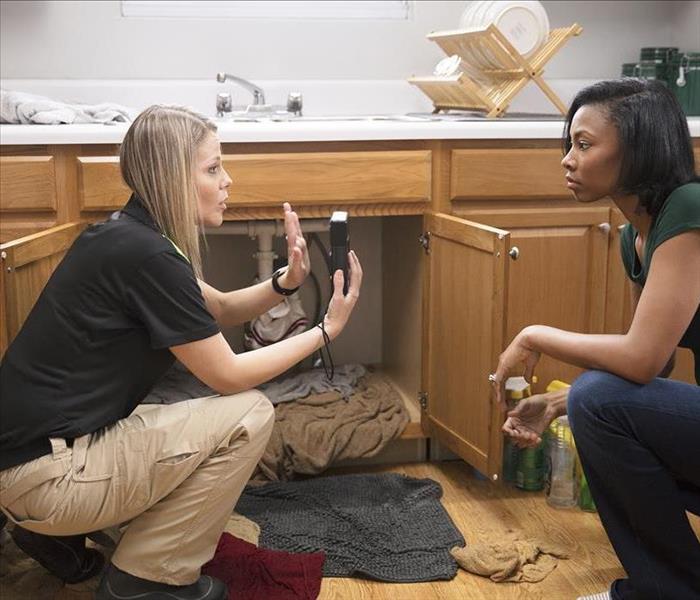 SERVPRO technicians working a residential water loss
SERVPRO technicians working a residential water loss
Unless you have worked for SERVPRO for any amount of time or dealt with catastrophic events such as a house fire or flood, you have probably thought little about the precautions that can be taken to avoid having them happen to you. The following are a few tips from SERVPRO employees that have seen a few things and tend to watch for in our own homes:
Unless you are actively using it, it should not be close to heat.
Putting your bacon on a plate with paper towels on it? Make sure it is far away from the hot surface. The paper towel WILL catch fire and cost you a great deal of money. Hot ironing your hair on the bathroom countertop? Move away all hair care bottles, brushes, towels, washcloths, hair ties, or anything else that you could accidentally set it down on, bump into, or knock into the heat.
DON’T leave running water unattended.
Even if it is in the garage. Even if the sink/drain has no prior issue of backing up. When you are busy enough to leave running water, you are busy enough to forget about running water. It will make its way to your attention before you are ready for it to.
Dishwasher Fires
It is most common for dishwashers to cause water damage and that still remains true. However, our employees never start their dishwasher before they leave the house unless they turn off the heated drying feature. It is SO common for the heating element at the bottom to get in contact with something that has fallen off the racks and start a fire that will do just as much damage as any other kitchen fire.
Grease Fires
Splattering grease is unavoidable sometimes when cooking in the kitchen. One of our employees has said that she never starts heavy cooking in the kitchen without having a bag of cornmeal or a box of baking soda on hand. Try to have something close by that can smother the fire that isn’t water.
How to Safely Deal With a Water Damage Emergency
4/13/2020 (Permalink)
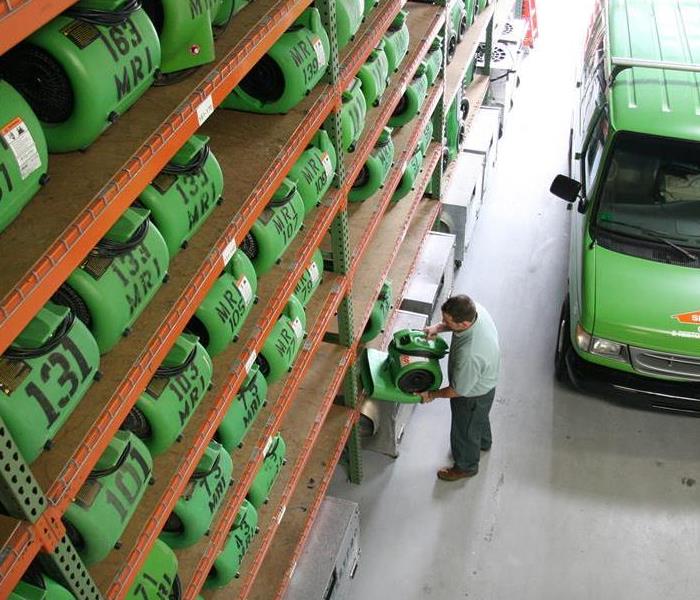 Here to Help
Here to Help
Summary: SERVPRO of Hurst-Euless-Bedford stresses the importance of prioritizing safety when dealing with a water damage emergency.
When a home or business owner is confronted with a large-scale water damage incident, it is vital to prioritize the safety of families, employees, customers, and other individuals. SERVPRO of Hurst-Euless-Bedford is sharing 7 safety tips to help people navigate the aftermath of a water damage emergency. These safety tips are applicable for residential or commercial water damage that is internally sourced from a leaky faucet, a cracked water pipe, or a broken water heater. Water damage resulting from a natural disaster such as a flood, tornado, or hurricane has a set of issues that go beyond the extent of an internally sourced water damage situation.
Tip #1: Stay calm. Do not panic.
Water damage to a home or business is stressful, especially if the water damages expensive furniture, ruins family heirlooms, destroys valuable inventory, or requires the property to be evacuated for a period of days or even weeks. Trained, experienced professionals take care of water damage emergencies every day, and they eliminate a large portion of the stress and anxiety. Skilled restoration experts do a thorough job in a timely fashion, so people do not have to worry.
Tip #2: Identify and eliminate electrical hazards.
A flooded house presents a challenge to the homeowner. Floor covering can be replaced, upholstery can be cleaned, and baseboards can be repainted. Electrocution, however, can be fatal.
The first concern is always personal safety, even before identifying the source of the flooding and shutting off the water. If the flooding is extensive, electrical shock is always a concern. Avoid stepping in the water until sources of potential electrical shock have been identified and resolved. Appliances and extension cords in the water are particularly dangerous. Be safe. Shut off the power from outside the home or commercial building. A water damage issue could turn into a fire hazard if electrical appliances are exposed to water.
Tip #3: Identify any chemical or sanitation hazards before entering the residence or building.
Strong smells, burning and itching eyes, or skin irritation may be indicators that the water may have come into contact with activated chemicals. Carefully do a smell test. Is the liquid on the floor more than water? Is it contaminated with raw sewage? It is unsanitary to track raw sewage throughout the entire house in the search for the water leak. What may have been a relatively simple clean up could be expanded to include the whole house.
Tip #4: Avoid slipping and falling.
Watch out for slippery surfaces. Wet floors can be exceedingly slippery, so hold on to cabinets or furniture when walking on slick kitchen or bathroom floors. Wear shoes or boots that provide stability and reduce the possibility of slipping and falling. It is better to keep shoes on while walking through the flooded areas to prevent slipping and to protect the feet from injury.
Tip #5: Use a flashlight when walking through areas that are dark or dimly lit.
If the flooding was so extensive that the electricity needed to be turned off, use a flashlight to illuminate the home. Proper lighting improves balance and stability. Groping around in the dark can lead to head and hand injuries. Further safety hazards can be created if furniture is turned over or glass is broken.
Tip #6: Wear rubber gloves and other protective clothing, if possible.
Wearing rubber gloves, protective eyewear, sturdy shoes or boots, and a mask or respirator are advisable if at all possible. If the leak has persisted over an extended period of time, mold, mildew, and bacteria may have had time to grow. Mold exposure can cause health effects. Also, the liquid on the floor and carpet may be contaminated with raw sewage. Chemicals may have mixed with the water and may have become activated, toxifying the air and the water. Any exposure to these contaminants could be hazardous or even deadly.
Tip #7: Avoid lifting heavy items.
Water-logged pillows, cushions, clothing, carpet, and padding are very heavy. Be careful walking across slippery surfaces. Carrying a heavy load or slipping unexpectedly can wrench the back or cause other injuries.
If the situation is severe and the environment is hazardous, the safest course of action may be to shut off the electricity and water, call the water damage specialists, and wait. Each crisis is unique and carries its own set of safety hazards. Immediate response from a water damage specialist is essential because much of the damage is done in the first few hours of the incident. Getting a trained technician with the best equipment on the scene as soon as possible is always a best-case scenario in a worst-case situation. For water damage restoration in Hurst-Euless-Bedford, TX, contact SERVPRO by phone at (817) 595-0004 or visit the website at https://www.SERVPROhurst-euless-bedford.com.
Categories of Water - Fort Worth
3/19/2020 (Permalink)
The presence of categories in water and water damage at face value might prove a relatively dicey idea to wrap your head around. A fact further exacerbated by the several research findings anchoring towards the notion of water possessing memory storage abilities, a capacity that's essentially supposed to be reserved exclusively to the human species.
We will not be delving into the metrics around water's memory capacity. In hindsight, though, one could still make a solid argument of Identity Politics has leaked into water (Pun intended) and fear that water damage is the new politically correct name for floods. Such an assumption possesses some degree of soundness; however, it couldn't be further from the truth, and rest assured it's still perfectly safe to say Floods for now.
Plausible Assumptions around Water Damage
We will kick things off by drowning out the assumption (Final pun). Breaking down Water damage to its most layman definition would unpack it as excessive water pooling in areas not initially designated for swimming pool purposes.
Still on edge with this definition? Granted, a pool in itself is harmless; however, when water gathers in places where it shouldn't be, it tends to seek outlets in pursuit of which damages ensue. Damages could be in the form of saturated carpets, cushions, ceilings, and floors. The saturated nature in themselves is damage enough; however, if left unattended translates into homes taking longer to restore and demanding unique drying methods, which can be costly.
Water Damage Sub-Categories
Water damage is primarily sub-categorized into two. First is the External water damage, predominantly caused by floods either from heavy rains or overflowing streams, making their way into your home or business location. Flooding is a common occurrence in Fort Worth owing to its geographical location in a tornado risk zone with storm winds recording speeds of 300 miles per hour, resulting in a torrential downpour and flash floods.
Secondly, we have Domestic water damage, the proponent of which in a nutshell can be sum up to faulty plumbing systems. We at SERVPRO, however, embrace the holistic definition of domestic. Unpacking this means, our technicians are not only capable and equipped with state of the art equipment crucial for intervening in water damages at your homes, but also acknowledge that your offices are at risk too.
We are also purposeful with our choice of words, by intervening in water damages we are fighting on two fronts. The first and rather obvious front is where we come in to alleviate the situation after the damage is already done.
We often get the call in the final moment when the basement is completely flooded or when the improvised bucket solution can no longer serve its course, the leaking office ceiling gives in, molds begin to appear, and the initial drip morphs into a downpour.
Due Diligence
When you first place the call, the SERVPRO respond desk will ask you a series of questions, the questions are aimed at helping us get a gist of your situation. A grasp of the case aside from enabling us to establish appropriate equipment and dispatch significant labor force also allows us to ascertain the category of water loss, which usually dictates the restoration procedure.
Water Loss Categories
The water damage category refers to the degree of water contamination in retrospect to its source of origin. There are three categories of water damage:
Category 1 or "clear water: This type of damage occurs when the water comes from a sanitary water source hence does not pose any significant risks if ingested. Sanitary sources include leaking water supply lines, melting snow/ice, falling rainwater, and overflowing sinks or tubs. In the early stages, water in this category is usually clear water. However, if not cleaned up promptly, it could quickly graduate into Category 2.
Category 2 or "grey water- water loss- This damage is experienced when the water contains contaminations with the potential of transmitting illnesses upon contact or consumption by humans. Contaminants range from organic and inorganic matter to unsafe levels of microorganisms. The pollutants give the water a Greyish color. Contaminated water sources include overflowing washing machines, overflowing toilet bowls, overflowing dishwashers, punctured water beds, and broken aquariums.
Category 3 or black water- Water loss: This type of damage, in most cases, come accompanied by unpleasant odors. The water in this category is Black water, highly contaminated, and riddled with toxigenic, pathogenic as well as other harmful agents (Silt, Pesticides) that can cause chronic illness or even death if consumed. Category 3 sources include; tropical storms and hurricanes invading the indoor environment, toilet overflow with feces, sewage, and flooding from seawater.
Water Damage Restoration Procedure
Once on-site, our team conducts an in-field inspection that guides their deliberation on an effective cleanup strategy and coming up with a service estimate. Once established, our technicians dive into the restoration process (Ignore pun):
- Water Removal: This is the first step in damage restoration. We extract all water; Floodwater, Sewage water, or Appliance water.
- Water Damage Mitigation: Depending on the degree of damage, in this step, we focus on recovering saturated carpets and cushions using industrial dehumidifiers and our air movers. We also clean and sanitize belongings at this stage.
- Water Damage Restoration: SERVPRO, in its capacity as a fully licensed construction and water damage restoration company in Texas will now return your property to its preloss condition as the final step. The restoration also involves the replacement of materials such as drywall and insulation.
Indicators of Water Damages
The preceding paragraphs only highlight the first front in our intervening strategies against water damages. We had alluded to two fronts, and the second front is preventive measure oriented. Water damage develops in severity over time primarily due to homeowners' ignorance, and though unintended, it's still naivety nonetheless. Awareness of the most common indicators of impending water damage will save our clients unnecessary expenses, signs such as
- An unusually cold home troublesome to regulate.
- Peeling paint
- Mold spore build-up
- The musty odor from basements or cellars
- Pooling water
- Discolored Walls
We pride ourselves as Fort Worth's best Restoration Company, not because of our not-so-dry sense of humor. But because we not only want you to call us after the fact to restore your office or home but also when you notice any of the common indicators. Finally, we are among the few companies offering to oversee your water damage claim that is, billing your insurance adjustor directly for the water damage restoration services provided.
Act Now
Ignoring leaks, unfortunately, only procrastinates on inevitable severe water damage. Contact SERVPRO of Hurst-Euless-Bedford today at 817.595.0004, let's work together to maintain your home or office space in its peak pre-water damage condition 24/7/365.
Winter Weather Preparations
9/26/2019 (Permalink)
While the weather is still in the 90s, and we are probably a few months away from our first freeze, it’s important to keep prepared from water damage in your home in case we do happen to get a deep freeze this upcoming winter. Make sure that your pipes are well insulated, especially those ones that are exposed to the air. You can get specialty foam to go around them. Use a sock to cover your outside waterspouts and put a foam cover on that too – it’ll give it extra insulation against the cold weather to prepare freezing and bursting. Make sure your gutters are clear too, to prevent outside water from getting in when it rains this season.
For a;; your home water damage needs, give us a call today at 817.595.0004!
Do you know where your water shut-off is?
5/22/2019 (Permalink)
A pipe bursts in your home, flooding about half of your home. Do you know where your water shut-off valve is in your home? If you took more than thirty seconds to answer that, then it’s probably a good idea to locate it in the event of a water emergency. In fact, learning where your water shut off valve is, is just as important as knowing where your breaker box is. Usually, your water shut off valve is next to your meter which can either be outside, or it can be a basement (if you’re fortunate to have one here in Texas!). Make sure everyone in your family knows where it is, and how to turn it off too, just incase you’re not home in the event of an emergency.
For all of your water damage restoration needs, give us a call today at 817.595.0004
Categories of Water
5/16/2019 (Permalink)
We can’t stress enough how important it is to get a water loss that’s happened in your home or business cleaned up as quickly as possible. We’ve already talked about how it can cause dangerous mold growth, but did you know that it can make you sick in other ways?
When you have a water loss in your home, you may hear about the category that the water that has flooded your home is. Whether it’s from us or your insurance adjustor, it may mean that there is more work to be done to your home that’s beyond drying with our air movers and dehumidifiers.
Category 1 or “clear water” – This type of water comes from a clean source, like a water supply line that has broken or been disconnected from an appliance. This type of water can also come from a tub that’s overflowed. It’s important to get this cleaned up as quickly as possible because it can quickly turn into a category 2 water loss as it sits.
Category 2 or “grey water” - This type of water comes from drains that have overflowed like dishwashers, sinks, or washing machines. It can make you sick, or just very uncomfortable.
Category 3 or “Black Water” – This type of water is the worst classification of water that you can have. This is very, VERY contaminated water. It contains toxins, pathogens and other harmful things that can cause severe illness or even death when exposed. This type of contamination comes from toilet overflow that has feces in it, sewer backups, ground water and flooding from streams and rivers. It’s important to get this type of water cleaned up IMMEDIATELY and get your home or business properly sanitized.
If you’ve found yourself with a water loss, don’t hesitate to call SERVPRO of Hurst-Euless-Bedford at 817.595.0004!
Rain, Rain Go Away!
5/8/2019 (Permalink)
The rain just doesn’t seem to want to stop – though, I’m not exactly complaining. I love rainy days here at SERVPRO of Hurst-Euless-Bedford. Though with the torrential downpours, we’ve seen streets flooded and we all know that that can lead to homes being flooded as well. Remember to turn around, don’t drown, and most importantly check your home before the next torrential rainstorm for possible leaks. Though, you can’t always prepare for a massive amount of water flooding through your garage and into your home, we can. We are on call 24/7, with emergency crews ready to dispatch at a moment’s notice and usually can be at your location within an hour.
Give us a call today at 817.595.0004, we are always “Here To Help!”
Your Floors & Water Damage
4/17/2019 (Permalink)
Kind of like an expensive car isn’t protected from hail damage, or dings in a parking lot even the most expensive floors aren’t protected from water damage. It can unfortunately destroy any type. Thankfully, there are signs. Here’s what to look out for just incase you suspect water damage to your flooring.
Carpet: If It’s smelly or discolored then it’s most likely got mold or mildew.
Laminate: Keep an eye out for any swelling, discoloration, or warping.
Tile: If you tap on the tiles with a coin and hear a hollow sound, it may mean the tiles have come loose. Cracking is another good sign.
Linoleum: Look for discoloration.
Hardwood: The easiest of all the flooring besides carpet to tell if your home has had water damage! Keep an eye out for dark spots that have mysteriously popped up recently, it could be mold or mildew. If your floor has started to cup or buckle, then it could mean water has gotten under and the planks of your floor have come loose due to water damage. And lastly, look for bulging or bubbling too your floor.
If you suspect your floor has had water damage, give SERVPRO of Hurst-Euless-Bedford a call today at 817.595.0004!
Here's How To Prevent Your Washing Machine From Giving You Unexpected Water Damage
4/17/2019 (Permalink)
Did you know that some of the most common ways for water damage in your home is caused by washing machines? And there are so many different ways that your washing machine can cause a water loss like a supply line bursting, clogging, using the wrong detergent and even overloading the washer. The supply hose is the most common way for your washing machine to fail.
It’s wise to do routine inspections of your supply hose. Keep an eye out for cracks, blisters or a loose connection. Replace any hose that looks worn and tighten them if they’re loose. You should also replace your hose every five years even if you can’t see any problems – just to be on the safe side. When you’re shopping for a new hose try to get one that’s braided steel as it’ll hold up to more wear and tear over time. If you’re away from your home for any extended period of time, shut off the water supply line valve to make sure nothing can happen while you’re away from home.
If you do have any water damage give us a call today at 817.595.0004!
When you've got a problem with water - let us handle it.
4/10/2019 (Permalink)
Water losses can be very scary! Sometimes you don’t know how or even why there is a giant puddle on your living room floor or the frustration of your dishwasher not working correctly – when it should be. It’s also stressful to even think about how you could even get that much water out of your home where do you even start? That’s where we at SERVPRO of Hurst-Euless-Bedford come into play.
We are a team of highly trained and specialized in water extraction on drying. We use specialized equipment to make sure that every drop of water is out of your home like air movers and extractors. We also make sure to use dehumidifiers to make sure your air is returned to the perfect level so no mold growth can happen.
If you find yourself with a water loss in your home or business, give us a call today at 817.595.0004
Spring Time Check Up!
4/8/2019 (Permalink)
It’s turning out to be a pretty wet spring here in North Texas, that’s for sure! With downpours both Saturday and Sunday, and then rain predicted for later this week – it’s important that we prepare our homes for weather related water damage.
Before the storms this week, take some time after work to take a look at your window seals, door jams, and roof to make sure that the hail this weekend didn’t cause any damage for water to leak in. Take a look around your attic too to make sure that there’s no unseen water damage that could cause mold growth in the future. If you haven’t already, clean your gutters from the fall debris so there’s no clogging. If you do have hail damage, make sure to get that taken care of as quickly as possible to ensure that no water damage can come into your home.
If you have suffered water damage this past week, give SERVPRO of Hurst-Euless-Bedford a call today at 817.595.0004!
What causes Pipes to Burst?
9/27/2018 (Permalink)
A burst pipe can cause some serious water damage to your home or business, but since pipes are generally located in walls or ceilings, it can be hard to keep an eye on them to make sure they are still working properly. The tips below will help you understand what causes pipes to burst so that you can avoid an unexpected water loss.
- Movement: Pipes that have not been secured properly may move around inside the walls and ceilings of your home or business. Turning the water on and off will cause them to shift around and bang against the walls; this movement weakens the joints of the plumbing and makes it easier for the system to start leaking or fall apart entirely. If you hear any clanging or banging inside your walls, get a professional in immediately to make sure that you plumbing is properly hooked up.
- Freezing: Unlike most substances that shrink when they get cold, water actually expands! When water freezes, the molecules align themselves in a way that causes the volume of the ice to take up more space than the liquid water. This means that if the water in your pipes freezes, the ice will push out on the sides of the pipe until it bursts open. To prevent this from happening, open your cabinets to let warm air reach your pipes and turn your faucets on to allows a slow trickle of water to run through the pipes.
- Water Pressure Changes: Making sure that your water pressure is steady is an important part of keeping your pipes whole and functioning. A large increase in pressure will cause the pipes to burst. Pressure can increase if some part of the pipe clogs or if something was not installed properly when the water lines were set up in your home. Locate your pressure gauge, and make sure to keep checking it for dramatic changes. If you spot high pressure, call a plumber to get it taken care of right away.
- Corrosion: Pipes are built to last for a long time, but that doesn’t mean that they are invincible. Sometimes, the galvanized coating that is used to waterproof the pipes can be worn down, and the pipes will begin to rust. Over time, the rust will build up inside the pipes which can cause pressure to build and pipes to burst.
Whatever the cause is, SERVPRO® of Hurst-Euless-Bedford is ready 24 hours a day to mitigate the damage.
817.595.0004
What is Storm Water?
5/29/2018 (Permalink)
Storm Water Do’s and Don’ts
What is Storm Water?
Storm water is precipitation that does not soak into the ground, but instead runs off its surface. Storm water runoff and erosion have begun to accelerate because of human activity. Impervious surfaces such as driveways, sidewalks, and streets block precipitation from soaking naturally into the ground. Disturbed surfaces, such as construction sites, agricultural tillage, and forestry activities, also expose the soil’s surface, allowing sediment and pollutants to be transported more rapidly from a site. Storm water can carry and deposit untreated pollutants, such as sediment, nutrients, and pesticides, into surface-water bodies.
Concerns about storm water
If storm water is not managed properly, it can harm the environment. The bullets below show more details on the harmful effects of storm water.
Increased Surface Runoff
Increased surface runoff means that large volumes of water enter streams more quickly and at higher velocities, which can cause streambank erosion. Streambank erosion occurs as part of a stream’s natural efforts to regain stability by absorbing the energy of flowing water. When materials impervious to water, such as pavement and concrete, cover the ground or when soils are compacted, runoff increases. With so much extra water running into creeks, streams, and other bodies of water, flooding is more likely to occur.
Increased Soil Erosion
Raindrops hitting a soil’s surface, and the movement of water (runoff) across it, cause soil erosion. Disturbed soil, lack of vegetation, or both amplify such impacts, increasing erosion. Usually, erosion goes unnoticed and doesn't cause much of a problem, but when enough soil is moved at once, we can end up with disasters such as mudslides.
Water Quality Impairments
After picking up debris, chemicals, dirt, and other pollutants, storm water flows into storm sewer systems or directly into lakes, streams, rivers, wetlands, or coastal waters. In many cases, whatever enters a storm sewer system is left untreated as it runs into larger bodies of water.
Storm Water Pollution Solutions
- Remember to turn off your sprinklers when it rains to avoid water runoff. during winter, runoff can freeze causing slippery conditions, so be sure to avoid letting sprinkler water build up on pavement.
- Bag your pet's waste, don't just leave it there. Leaving pet waste on the ground increases public health risks by allowing harmful bacteria and nutrients to wash into the storm drain and eventually into local waterways.
- Don't apply pesticides, fertilizers and herbicides before it rains. Contrary to popular belief, the rain won't help to soak these chemicals into the ground; it will only help create polluted runoff into our local creeks.
- Select native and adapted plants and grasses that are drought and pest resistant. Native plants require less water, fertilizer, and pesticides.
- Reduce the amount of paved area and increase the amount of vegetated area in your yard. Vegetation can help act as a natural filter for polluted storm water runoff.
- If you change your car's oil. Don't dump it on the ground or in the storm drain; dispose of it properly at an oil recycling center.
- Check your car, boat, or motorcycle for leaks. Clean up spilled fuels with an absorbent material, don't rinse the spills into the storm drain.
- Compost your yard waste.
- Don't get rid of old or unused paint by throwing it down the storm drain; dispose of paint and other hazardous household waste at recycling facilities.
- Don't pump your pool water into the storm drain - pool chemicals can be hazardous to our creek habitats. Whenever possible, drain your pool into the sanitary sewer system where it can be treated.
SERVPRO of Hurst-Euless-Bedford 817.595.0444
Water Damage anyone…
5/21/2018 (Permalink)
Water Damage Anyone?
Unfortunately, you may be here because you have or have had water damage. SERVPRO of Hurst-Euless-Bedford is available 24 hours a day, 7 days a week, 365 days a year for your water cleanup and restoration needs. The following list shows a timeline of the effects water can have on a structure:
Within Minutes:
- Water quickly spreads throughout your property, saturating everything in its path.
- Water is absorbed into walls, floors, upholstery, and belongings.
- Furniture finishes may bleed, causing permanent staining on carpets.
- Photographs, books, and other paper goods start to swell and warp.
Hours 1-2:
- Drywall begins to swell and break down.
- Metal surfaces begin to tarnish.
- Furniture begins to crack and swell.
- Dyes and inks from cloth and paper goods spread and stain.
- A musty odor appears.
48 Hours to 1 Week:
- Mold and mildew may grow and spread.
- Doors, Windows, and studs swell and warp.
- Metal begins to rust and corrode.
- Furniture warps and shows signs of mold.
- Paint begins to blister.
- Wood flooring swells and warps.
- Serious biohazard contamination is possible.
More Than 1 Week:
- Restoration time and cost increase dramatically; replacing contaminated materials and structural rebuilding may be extensive.
- Structural safety, mold growth, and biohazard contaminants pose serious risk to occupants.
SERVPRO of Hurst-Euless-Bedford can assist you with your claim to the insurance. Our water certified administrative team works closely with your insurance provider as our trained and certified technicians work diligently to return your home to pre-water conditions. Our technicians are credited on IICRC principles which brings a peace of mind to homeowners in water cleanup and restoration situation.
Do you have water damage?
The team at SERVPRO of Hurst-Euless-Bedford are here to answer and assist you with your water damage.
24-Hour Emergency Response Team
817-595-0004
Water Damage from Condensation
5/16/2018 (Permalink)
Water Damage from Condensation
Condensation happens when there’s too much moisture for a certain temperature. In other words, condensation happens when warm, moist air touches a surface colder than the air. That air releases moisture in the form of water, which appears on the colder surface. You’ve seen it coming out of a cold glass on a warm day, and you can see this on-air conditioners too.
Air Conditioning Condensation
Your air conditioner pulls humidity from the air. As warm air flows through the evaporator coil, it absorbs heat and collects moisture. This moisture drips down into what is called a drain pan or condensation pan. You may have noticed a small dripping line coming from the outside condenser unit. This is your AC’s drain line, which helps remove condensation produced by your air conditioner’s evaporator coil. The drain line dumps water outside of your home, so it’s normal to see wet spots around your outdoor unit.
The problem lies when your indoor unit starts pooling water! If you notice water buildup coming from your indoor AC unit, you should turn it off and call a professional immediately. Excess water will harm the parts of your air conditioner and lead to water damage to your home. This damage will be costly! If your drain pan overflows, the water can back up and wreak havoc on your home! If the condensation pan and line aren’t cleaned properly, algae and mold can grow inside them, which could cause clogging as well. This could also increase humidity and create musty odors and water damage to your home.
Frozen Evaporator Coil
You probably already know that air filters must be changed regularly to keep your air conditioner working properly. If the filters become clogged, the evaporator coil can quickly form layers of frozen condensation. Yes, ice. If you see ice buildup on your evaporator coils, it’s not a cool thing. That’s because the water buildup from a frozen evaporator coil will eventually spill over the condensation pan and onto the floor. So, whether it’s a frozen or dirty evaporator coil or a clogged drain line producing condensation, any excess water your AC can’t process has nowhere to go but back into your home.
Excess condensation from your air conditioner leads to serious water damage. If you notice leaking water other than the normal drain line drip outside your AC, it’s a sign of huge problems ahead. If you notice mold or mildew growing around your air conditioner, or notice a marked change in the humidity of your home, it’s time to call an AC professional!
Roof Water Damage
We mentioned condensation around your windows and AC, but also look at your ceiling and roof. They will give you signs of impending water damage such as mold, mildew, and water spots. You should be able to easily identify broken or missing shingles, as well as discolored patches on your roof. Missing or damaged shingles are a result of weather damage, specifically rain.
Shingles are designed to protect your roof from the elements. And if your shingles are damaged or missing, water will eventually start making its way into your home. It starts with a small drip, but if that small drip isn’t addressed, it will become a much larger drip. That large drip could then lead to ceiling or roof collapse.
Insulation
Deteriorated insulation can also create excess humidity in your home. A well insulated home will help control condensation. Traditional insulation, like fiberglass, can wear out and get wet; therefore, spray foam insulation exists! Spray foam insulation creates an airtight seal that bonds to the infrastructure of your home. It strengthens the foundation, keeping indoor air in and outdoor air out. A poorly insulated home could lead to excess moisture in the attic or crawl spaces, which creates condensation.
High humidity also produces mildew, bacteria, and microbial growth. Condensation, microbial growth, and mildew lead to building damage. Mildew can distort wood and eat through drywall. And nasty pests, like cockroaches and rats, are attracted to humid, wet areas. Rats and other rodents are even known to make nests out of fiberglass insulation. Insulating your home with long-lasting, durable, spray foam insulation helps keep pests out. It will also strengthen your walls and your roof and help prevent water damage to your home.
Call SERVPRO of Hurst-Euless-Bedford today for any concerns regarding water damageat 817.595.0004.
5 Residential Water Leaks
5/12/2018 (Permalink)
5 Residential Water Leaks
Water damage is a lot more serious than many people think and, if not remedied immediately can cause home owners much damage. Here are five ways to find out if you have a water leak.
The water supply line - This type of leak can go undetected because the supply pipe is under the ground. If the meter contains water and the water is not caused by rain than there may be a leak. In most cases the homeowner is liable for this kind of leak and should contact a professional plumber to repair the line.
Faucet leaks - This is the most common kind of leak but the easiest to repair. Facet leaks are so moderate the amount of money lost from water wastage is minimal. Make routine checks of all valves to see if there is leakage or not with faucets. If you are handy with tools you should easily be able to make the repairs yourself.
Toilet leaks - These are barely detectable because they make no sound. Research proves that one fifth to one third of all residential toilets are prone to leaks. Start by removing the lid off the tank and making sure the water level is not above the overflow tube. This is the most common form of leak.
Humidifier leaks - Humidifiers are connected to the furnace and level with the water supply line. All the components are equipped with refill valves. When the valve won’t close the water goes to the sewer which creates a leak that can go undetected for months or years. Be sure to turn humidifiers off when the season for it is over.
Evaporator cooler leaks - Evaporator coolers cool the air sent in homes. Leaks are caused in these the same as with humidifiers and is remedied the same by shutting it off when not in use.
Here at SERVPRO of Hurst-Euless-Bedford, we have the training, equipment and leadership you need to fully restore your property with minimal disruption to your family or business. We provide full-service solutions for restoring your property to preloss conditions or better.
Have a water leak? Call SERVPRO of Hurst-Euless-Bedford today!
817-595-0004
What is Water Damage?
5/2/2018 (Permalink)
What is Water Damage?
Water damage is damage caused to your property by water being where it shouldn’t be. In some cases, this will be the result of a flood or of malfunction – a burst pipe or water main, for instance, will commonly lead to water damage that is highly acute and that requires immediate attention.
This type of water damage can be caused by three types of water called category 1, 2 and 3. Category one water is clean and clear water (also called ‘white’ water) whereas category three is dirty water that can be toxic and cause infections and illness (also called black water). This adds another dimension to your water damage in the latter case.
This is, of course, the ‘obvious’ type of water damage that is very apparent when you see it. Just as common though is for water damage to be subtler and to easily go unnoticed until you can identify the symptoms. Signs of water damage include things like puddles, dripping water, soft walls and floors, peeling tiles and discoloration. Mold is also a big sign that there has been water damage.
When water damage is more gradual like this, then you will need the services of SERVPRO of Hurst-Euless-Bedford on a less urgent basis – but you should nevertheless aim to get it looked at as soon as possible to ensure that you prevent it from spreading and to protect your health and the health of your family. Moisture in the air and particularly mold spores can otherwise be very bad for you and your family. At the same time, if moisture affects your building deeply, it can end up undermining the structural integrity of your building.
If you notice you have water damage of the immediate kind, you call SERVPRO of Hurst-Euless-Bedford a water damage restoration company that offers emergency 24-hour emergency response services. SERVPRO of Hurst-Euless-Bedford technicians are IICR certified. This is highly important when you have a serious influx of water and failing to do so can result in more costly damage to your property.
In the meantime, you can try moving items out the way that might be at risk, turning off the stop tap to isolate your water supply (if it is caused by your pipes) and potentially turning off the electricity by finding your fuse box. If the water is very fast, however, your priority should be to get yourself and your family off the premises and to safety.
In either case, you should contact SERVPRO of Hurst-Euless-Bedford early so that they can come to your aid.
What Can SERVPRO of Hurst-Euless-Bedford Do for You?
When SERVPRO of Hurst-Euless-Bedford arrives, our technicians will first and foremost find the source of the water and stop it where possible. This might involve repairing damage to your walls or your roofing, or it might mean fixing a pipe or blocking flood water. Either way, the SERVPRO of Hurst-Euless-Bedford will prevent the water from flooding your property any more so that they can get to work fixing the problem. In the case of gradual water damage, probes and infrared sensors can be used to find out where the problem is coming from and what needs to be done to fix it.
To prevent future water damage, it’s a good idea to make sure that you use regular maintenance services to check over your plumbing and your roofing. In your bathroom and other rooms, you should make certain that you have good adequate ventilation and you should use good insulation in your windows and walls – especially if you have a basement. Make sure as well to clean your gutters regularly and to make sure that there is no overspill. If you are buying a new home, then make sure to research the area first to avoid houses on flood plains.
SERVPRO of Hurst-Euless-Bedford 817.595.0004.
The Categories of Water Damage
4/27/2018 (Permalink)
The Categories of Water Damage
The Category of Water
According to IICRC Standard and Reference Guide for Professional Water Damage Restoration(IICRC S500), there are three categories of water that cause damage in buildings. They are summarized as follows:
Category 1 Water (Clean Water)
Water that originated directly from a sanitary source and when exposed to it, either through the skin, inhaled or ingested, does not cause a great deal of harm to humans. Examples of Category 1 Water: broken water supply lines, melting ice or snow, falling rain water, and tub or sink overflows (no contaminates). Category 1 water may become progressively contaminated as it mixes with soils on or within floor coverings or building assemblies (walls, decking, subflooring). Time and temperature, which promote the growth and amplification of microorganisms in water can cause Category 1 water to degrade
Category 2 Water (Gray Water)
Defined as water with bacteria present, but no solid waste, carrying microorganisms and nutrients for microorganisms. Category 2 water does have the potential to cause discomfort or sickness if consumed or exposed to humans. Examples of Category 2 water: discharge from dishwashers or washing machines, toilet bowl overflows (urine, no feces), seepage due to hydrostatic pressure, and sump pump failures.
Category 3 Water (Black Water)
Contains pathogenic agents and is grossly unsanitary which includes raw sewage and other contaminated water sources, such as flooding from sea water, ground surface water and rising water from rivers or streams. Category 3 water is highly contaminated and could cause death or serious illness if consumed by humans.
Here at SERVPRO of Hurst-Euless-Bedford we are here to help you with your water mitigation and restoration needs.
Call us today at 817.595.0004.
What is Water Restoration?
4/18/2018 (Permalink)
What is Water Restoration?
Water Restoration is the restoring of your home to pre-damage conditions involves water removal, decontamination, and drying.
Standing water and moisture create the perfect environment for bacteria and microbial growth. Prolonged exposure to an environment like this can lead to allergic reactions and even disease.
Parts of a water-damaged home may need to be rebuilt. Materials like drywall and carpet that have absorbed water often develop bacteria and microbial growth that can’t be removed. Replacing these materials is safer than allowing infectious organisms to saturate the air.
SERVPRO Water Restoration Process
Repairing a water damaged home involves a process starting with a thorough inspection of the damage to the replacement of flooring, walls, and ceilings.
Step 1: Inspection – SERVPRO of Hurst-Euless-Bedford can best assess the extent and amount of water damage in your home. Each inspection determines a class and category of water damage. Defining the class and category of water damage helps outline the best means to restore your property.
Step 2: Water Removal – Pumps and vacuums are used to remove water from your home. The type of equipment needed depends on the extent of the water damage. Water removal begins as soon as possible to prevent mold and bacteria growth.
Step 3: Drying – After all standing water and absorbent surfaces are vacuumed, drying and dehumidification begins. This step is important to clear up any remaining moisture after water removal. The drying out process can take several weeks to fully complete.
Step 4: Cleaning – All personal belongings need to be cleaned and sanitized to prevent unwanted mold and bacterial growth. Carpeting, clothing, and drapery are given antimicrobial treatments. Air scrubbers may also be used to remove particles and moisture from the air.
Step 5: Restoration – The biggest step in the process is restoration. The restoration involves replacing materials like drywall and insulation. Sometimes this process is as simple as installing a few panels of drywall, while serious cases could require replacing entire walls. Exposure to toxic substances like lead and asbestos is possible during restoration. Older homes are likely to contain these substances.
Here at SERVPRO of Hurst-Euless-Bedford are here to help you with whatever happens. Our 24-Hour Emergency Response is in place to help you no matter the time of night or day.
Call us today 817.595.0004
Water Mitigation Process in Progress
4/18/2018 (Permalink)
Water Mitigation Process in Progress
The reasons of water damagecan be different, such as flooding from storms, frozen or ruptured pipes. Whatever the reason, you’ll have to overcome some real hurtles and prevent more serious problems. You probably want to know, what should you do first? Here are some useful tips to keep water damage at a minimum and make the restoration process easier and faster. All the doings you read below are called the water mitigation process.
The Process of Water Mitigation
When your home is damaged by a flood, it is important to start the water damage mitigation process as soon as possible. It is not a secret, the earlier the better. The longer you wait the more damage the water does. If you do not call for the experts fast, your home and surrounding may suffer irreparable damage that can be very expensive to deal with.
It is important to make sure that you hire specialists who are certainly certified by the Institute of Inspection Cleaning and Restoration Certification. You should know that the IICRC is one of the largest certifying bodies in the United States. When you hire a company that has IICRC certification, you can feel confident that you will receive the highest quality of care and that your home will be restored as quickly and efficiently as possible.
Watch Out for Danger!
The danger in the flooded house is everywhere. First, check for anything that could harm you. Turn off all power and gas in rooms that have sustained water damage. Watch for animals, sometimes dangerous insects and other things that usually come in with the water during floods. Standing water needs much attention for every step. It is dirty and can be hard to see through, be wary of debris underneath the water. At last, the water can contain dangerous pathogens or chemicals. So, one way or another, it is better to wear waterproof clothing.
Mold after Water Damage
In most cases, water damage leads to microbial growth. So, it’s important to keep on it. Do you know why? Everyone knows but we need to repeat is again. Mold causes a variety of health problems including respiratory health issues and asthma attacks in those with asthma as well as other unpleasant effects even for healthy folks.
Water damage can diminish the construction of your home especially if your property has been flooded for some time. Look at the foundation, your load-bearing walls, your basement, and any columns for crumbling and cracks.
Wear Waterproof Clothing
It was already discussed many times about the dangerous pathogens and possible chemicals that you can find in the standing water. You should cover up fully with goggles, gloves, a helmet and a mask. That means that you should wear special clothes to protect yourself. Make sure that anything that was in the area that sustained the water damage is thoroughly disinfected, that includes yourself and your equipment.
Take Photos
Don’t be surprised! Once you’ve followed the above steps you will then be able to look at the damage and document it. Pictures of the water damage will be important when dealing with your insurance agency. If you are not insured, you don’t need to take pictures.
Dry Out Your Home or Building
It’s important to be quick about drying out your home or building to minimize the possibility of mold growing and of deterioration of the structure. Drying is the most important process as you shouldn’t only dry all the surfaces but not to damage it. This is the first thing you must do is get the water out your home or building. Of course, the longer your house stays flooded, the more damage it sustains. You can sweep a lot of the water through an open door if you have access to one. If the water is in the basement or a room without access to a door, you’ll want to use a pump. SERVPRO of Hurst-Euless-Bedford has specialty equipment. It helps to dry the surfaces faster and till the bottom.
Inspect the Attic for Water Damage
You may not know this but the insulation in your walls can carry the water up to the attic so the best place to start is there. Considering that water can stay in the insulation for some time coupled with how hot attics can get, this is a recipe for mold and wood rot. Of course, if you were flooded from the pipe in your bathroom, you can forget about the attic inspection.
Ventilate the Area Suffering from Water Damage
Check all flooded rooms for moistened sheetrock and plaster. If you see signs of moisture, open your windows turn on your attic fan, if your electrical system has already been checked. Ventilation is important. You need room airing as much as drying.
Disinfect the Area
After you’ve ventilated the rooms and removed all wet materials, you should clean everything with a disinfectant such as bleach with water. This is the simple example of disinfectant that you can buy in the store. But make sure you wash everything to remove the residue from the water damage. Otherwise, your kids or animals that spend much time playing on the floor can be in danger.
When in doubt call SERVPRO of Hurst-Euless-Bedford
If you’re suffering from water damage you can follow these steps to do water mitigation process in the fastest time. If you need any help or if the job is just too large for you to handle alone, call SERVPRO of Hurst-Euless-Bedford 817.595.0004. Our Response Team is ready 24-Hour / 7 Days week / 365 days of the year.
Flood Awareness
4/14/2018 (Permalink)
Flood Awareness
While dangerous floods and flash floods are possible throughout the year, they have a higher frequency during spring and summer thunderstorms, tropical storms and hurricanes. Intense rainfall or slow-moving storms that track over the same areas can cause a rapid rise of water and flash floods can develop within minutes.
On May 6, 2017, Governor Greg Abbott proclaimed May 22-26, 2017 to be Flood Awareness Week in Texas.
All residents should know the implications of flood watches and warnings, assemble an emergency supply kit; develop a communication plan for reaching family members, friends, neighbors and coworkers in case of an emergency; and designate a meeting place in case of evacuation.
Flooding is the most common natural disaster in the United States and can happen anywhere. How to Prepare for a Flood explains how to protect yourself and your property and details the steps to take now so that you can act quickly when you, your home, or your business is in danger.
FLOOD BASICS
WHAT: Flooding is an overflowing of water onto land that is normally dry. Flooding may happen with only a few inches of water, or it may cover a house to the rooftop.
Flooding can occur during any season, but some areas of the country are at greater risk at certain times of the year. Coastal areas are at greater risk for flooding during hurricane season (i.e., June to November), while the Midwest is more at risk in the spring and during heavy summer rains. Ice jams occur in the spring in the Northeast and Northwest. Even the deserts of the Southwest are at risk during the late summer monsoon season.
WHERE: Flooding can happen in any U.S. state or territory. It is particularly important to be prepared for flooding if you live in a low-lying area near a body of water, such as a river, stream, or culvert; along a coast; or downstream from a dam or levee.
HOW: Flooding can occur in several ways, including the following.
- Rivers and lakes cannot contain excessive rain or snowmelt.
- Excessive rain or snowmelt cannot be fully absorbed into the ground.
- Waterways are blocked with debris or ice and overflow. - Water containment systems break, such as levees, dams, or water or sewer systems.
- Strong winds from tropical storms or hurricanes cause a storm surge by pushing seawater onto land.
The speed and duration of flooding can vary significantly.
- Flooding can occur slowly as rain continues to fall for many days. This type of flooding, sometimes called a slow-onset flood, can take a week to develop and can last for months before floodwaters recede.
- Rapid-onset floods occur more quickly, typically developing within hours or days. These types of floods usually occur in smaller watersheds experiencing heavy rainfall, particularly in mountainous and urban areas, and the water usually recedes within a few days.
- Some rapid-onset floods known as flash floods occur very quickly with little or no warning, such as during periods of extremely heavy rain or when levees, dams, ice jams, or water systems break. Densely populated areas are at a high risk for flash floods. In urban areas, flash floods can fill underpasses, viaducts, parking structures, low roads, and basements.
- The strong winds of a tropical cyclone or hurricane can push large amounts of seawater up onto the land, causing a storm surge. A storm surge combines with the ocean’s tide to produce a storm-tide surge. Storm-tide surges have been registered as high as almost 35 feet above normal sea level and can cause significant flooding across a large area. This generally occurs over a short period, typically 4 to 8 hours, but in some areas, it can take much longer for the water to recede to its pre-storm level.
IMPACT
The physical destruction caused by flooding depends on the speed and level of the water, the duration of the flood, terrain and soil conditions, and the built environment (e.g., buildings, roads, and bridges).
- Flooding can cause fatalities and serious injuries for people who are trapped or swept away by wading in, driving through, or boating across floodwaters.
- Transportation routes, power, water, gas, and other services may be disrupted. - Commercial supplies and government support systems may be temporarily unavailable.
- Drinking water supplies and wells may become polluted.
- Floodwaters can cause erosion, which can damage roads, bridge structures, levees, and buildings with weak foundations, causing their collapse without warning. The floodwaters may carry the worn-away mud, rocks, and other sediment.
- Landslides and mudslides can occur.
- Even a few inches of floodwater in a home can cause tens of thousands of dollars in damage.
https://www.weather.gov/
Here at SERVPRO of Hurst-Euless-Bedford, we are prepared to help you with our 24-HOUR EMERGENCY RESPONSE. Call us 817.595.0004
Concepts of Water Damage
4/9/2018 (Permalink)
The Concepts of Water Damage Restoration
SERVPRO of Hurst-Euless-Bedford technicians are certified for drying excessive water damage. Accidents such as sewage backup, flooding, and broken pipes can happen to anyone. Quick action is necessary to stop further degradation of the property.
Our trained and certified technicians start the process by first stopping the flow of water. Without stopping the flow of water, the technician will not be able to start the repairing process of the residence. Stabilization the source is critical to proceed with the drying process and restoration.
To begin the drying process is water extraction SERVPRO of Hurst-Euless-Bedford has numerous pieces of equipment that remove the excess water and moisture from the residence. We have tools that measure the moisture during the drying process.
Air movers are utilized to cycle the air which is an important process. The technician learns how to choose the right air movers, and how to place them properly for maximum results.
The proper solution to help with the drying process and lessen the damage the structure of your home and belongings is evaporation. Evaporation is natural with proper circulation. This process is used to speed up the process or it can prevent the process.
SERVPRO of Hurst-Euless-Bedford technicians are trained in evaporation so to hurry the drying of the structure and furnishes along. This technique will prevent microbial growth and the structure will be stabilized. Every step of the drying process is critical for a positive outcome.
Call SERVPRO of Hurst-Euless-Bedford for your residential water damage at 817.595.0004.
Water Damage in Grapevine, Texas
10/16/2017 (Permalink)
Recently a home in Grapevine Texas flooded due to a water main break under the foundation. We were called in to begin the restoration process and were able to quickly extract the water to avoid any mold growth and any further damage to building materials. When a home is flooded it is very important to extract the water as soon as possible.
The following list shows a timeline of the effects water can have on a structure:
Within Minutes:
- Water quickly spreads throughout your property, saturating everything in it’s path.
- Water is absorbed into walls, floors, upholstery, and belongings.
- Furniture finishes may bleed, causing permanent staining on carpets.
- Photographs, books, and other paper goods start to swell and warp.
Hours 1-2:
- Drywall begins to swell and break down.
- Metal surfaces begin to tarnish.
- Furniture begins to crack and swell.
- Dyes and inks from cloth and paper goods spread and stain.
- A musty odor appears.
48 Hours to 1 Week:
- Mold and mildew may grow and spread.
- Doors, Windows, and studs swell and warp.
- Metal begins to rust and corrode.
- Furniture warps and shows signs of mold.
- Paint begins to blister.
- Wood flooring swells and warps.
- Serious biohazard contamination is possible.
More Than 1 Week:
- Restoration time and cost increase dramatically; replacing contaminated materials and structural rebuilding may be extensive.
- Structural safety, mold growth, and biohazard contaminants pose serious risk to occupants.
Have any questions? Call Us Today! We here at SERVPRO of Hurst-Euless-Bedford are here to help!
817-595-0004
24 Hour Emergency Water Damage Service
5/8/2017 (Permalink)
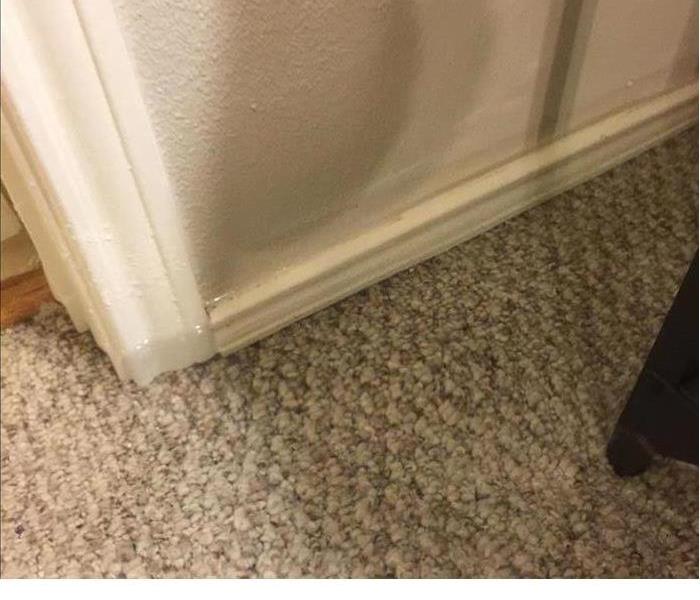 SERVPRO of Hurst-Euless-Bedford provides 24 hour water damage restoration service
SERVPRO of Hurst-Euless-Bedford provides 24 hour water damage restoration service
SERVPRO of Hurst-Euless-Bedford is available 24 hours a day for water emergencies, large or small. When you are dealing with water damage, immediate action is crucial. A delay of just a few hours can greatly increase the severity of the water damage.
We Answer the Phone Ready to Help
Call Today - 817-595-0004 or 817-595-2506
We understand that when you call us, you may be feeling confused, stressed, and vulnerable. You need an expert to guide you through this crisis. SERVPRO of Hurst-Euless-Bedford has the specific water damage training and experience to help you through this tough time. We specialize in water damage restoration—in fact, it's the cornerstone of our business.
What to Expect
When you call, we will ask several questions regarding your water damage emergency. These questions will help us determine what equipment and resources to bring, including how many trained SERVPRO Professionals may be needed.
Our SERVPRO Representative will ask several questions:
- Your name and contact information
- Your insurance information (if applicable)
- The street address of the water-damaged home or business
- When did the flooding or water damage occur?
- What caused the water damage (if known)?
- Is there electricity available (on-site)?
We are Water Damage Specialists:
- We are Available 24 hours/7 days per week
- Family owned and operated franchise
- We Bill the Insurance Directly - One Less Thing for You to Worry About
- Our Technicians are Highly-Trained in Water Restoration Techniques
- Commercial and Residential Services
- More than 45 years of experience
- FREE Estimates and FREE Inspections
Have Questions? Call Us Today - We're Here To Help
817-595-0004 or 817-595-2506
http://www.SERVPROhurst-euless-bedford.com/
Follow us on Twitter @SERVPROHEBG
And Facebook/SERVPRO of Grapevine/NE Tarrant Co & HEB
Water Damage - Bedford, Texas
5/8/2017 (Permalink)
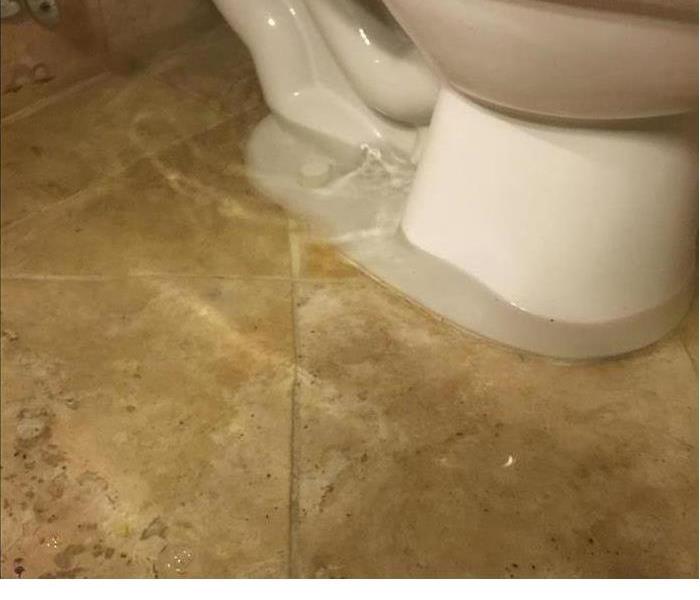 This home in Bedford, Texas suffered water damage from an overflowing toilet
This home in Bedford, Texas suffered water damage from an overflowing toilet
Water damage—from a broken pipe, a leaky roof or a sink overflow—can cause significant damage to your home, especially if the damage is not properly repaired. This home in Bedford, Texas suffered water damage from an overflowing toilet.
There are some simple steps you can take until help arrives:
- If the source of water is still leaking, identify the source and stop it if you can.
- If the water is coming from a burst or leaking pipe, turn off the water at its source.
- If the water is coming through the roof or broken windows, try to cover them to prevent further damage.
- Move wet items to drier areas.
- Place aluminum foil coasters or wood blocks between furniture legs and wet carpeting.
- Save damaged items and any parts you may need to replace— your claims representative may want to inspect them.
- Do not use electrical equipment or appliances while standing on wet carpet or floors.
- To document the damage, make a list of the temporary repairs you make and take photographs.
- Make sure to save your receipts
We are Water Damage Specialists:
- We are Available 24 hours/7 days per week
- Family owned and operated franchise
- We Bill the Insurance Directly - One Less Thing for You to Worry About
- Our Technicians are Highly-Trained in Water Restoration Techniques
- Mold remediation and prevention
- More than 45 years of experience
- FREE Estimates and FREE Inspections
Have Questions? Call Us Today - We're Here To Help
817-595-0004 or 817-595-2506
http://www.SERVPROhurst-euless-bedford.com/
Follow us on Twitter @SERVPROHEBG
And Facebook/SERVPRO of Grapevine/NE Tarrant Co & HEB
Water Damage - Euless, Texas
5/8/2017 (Permalink)
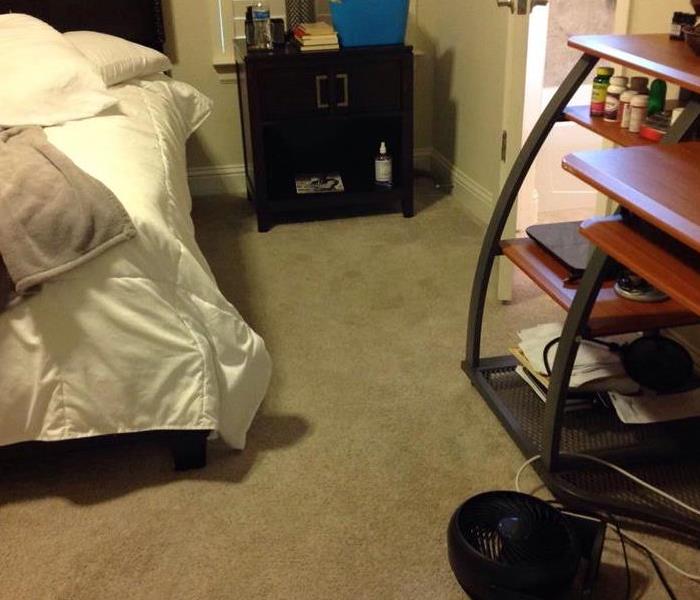 This Hurst, Texas suffered water damage from an overflowing bathtub. We were called in to perform the water extraction.
This Hurst, Texas suffered water damage from an overflowing bathtub. We were called in to perform the water extraction.
This home in Hurst, Texas suffered water damage when a bathtub overflowed. We were called in to perform the water extraction. We arrived within one hour of being notified of the loss to begin the water extraction process. When the water removal was complete, we started the drying process immediately. The homeowners were extremely thankful for our quick response time. Most of the flooring throughout the home had to be removed, but we worked quickly to remediate the damage and the drying was complete within 5 days.
Our Water Damage Restoration Process
Every water disaster is different, from the amount of water to the level of contamination of the water. Each scenario requires a unique solution, but the general process stays the same. The steps listed below illustrate our process for the “typical” water damage emergency.
- Step 1: Emergency Contact
- Step 2: Inspection and Damage Assessment
- Step 3: Water Removal/Water Extraction
- Step 4: Drying and Dehumidification
- Step 5: Cleaning and Repair
- Step 6: Restoration
We are Water Extraction Specialists:
- We are Available 24 hours/7 days per week
- Family owned and operated franchise
- We Bill the Insurance Directly - One Less Thing for You to Worry About
- Our Technicians are Highly-Trained in Water Restoration Techniques
- Mold remediation and prevention
- More than 45 years of experience
- FREE Estimates and FREE Inspections
Have Questions? Call Us Today - We're Here To Help
817-595-0004 or 817-595-2506
http://www.SERVPROhurst-euless-bedford.com/
Follow us on Twitter @SERVPROHEBG
And Facebook/SERVPRO of Grapevine/NE Tarrant Co & HEB
Water Damage - Hurst, Texas
5/8/2017 (Permalink)
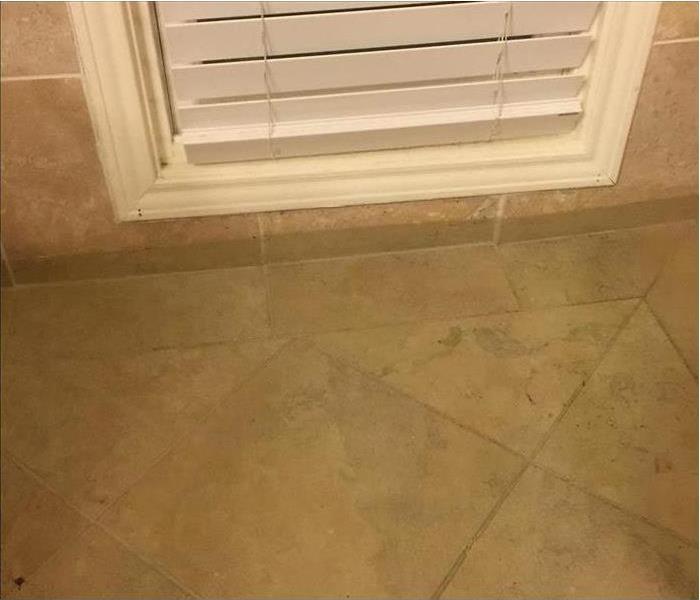 A Hurst, Texas home flooded when a sink overflowed
A Hurst, Texas home flooded when a sink overflowed
This Euless, Texas home suffered water damage when sink overflowed. We were called in to perform the water extraction.
Avoiding a sink overflow isn’t hard to do. You just have to keep in mind that most overflows happen due to a clogged drain. If you can keep your drain clear, water should be able to flow to the sewers as it’s intended to. Here are a few tips on just how to do that:
- Don’t dispose of food scraps through your sink. They may fit in the drain, but as more and more food particles accumulate, they can form a solid clog that will restrict water movement.
- Just because fat, oil and grease look fluid doesn’t mean they’ll go right along with water to the sewers. These substances can deposit and solidify in your drainage pipe and cause a clog later on.Visit ceasethegrease.org to learn more about proper grease disposal and avoid FOG related clogs.
- Avoid getting hair into your sink. Like solid food particles, hair can accumulate, ball up and create a barrier that prevents the escape of water into the sewage system.
- Always have a drain cover to filter out large, solid objects that may fall into your sink’s drainage pipe. Remove them only when cleaning your sink.
- Don’t let your kids play with water in your sink. Children can get very creative and they’ve been known to try and flush small toys down sink drainages. Action figures and toy cars are some of the most difficult clogs to clear, so educate your kids on this subject early on.
We are Water Removal Specialists:
- We are Available 24 hours/7 days per week
- Family owned and operated franchise
- We Bill the Insurance Directly - One Less Thing for You to Worry About
- Our Technicians are Highly-Trained in Water Restoration Techniques
- Mold remediation and prevention
- More than 45 years of experience
- FREE Estimates and FREE Inspections
- Have Questions? Call Us Today - We're Here To Help
817-595-0004 or 817-595-2506
http://www.SERVPROhurst-euless-bedford.com/
Follow us on Twitter @SERVPROHEBG
And Facebook/SERVPRO of Grapevine/NE Tarrant Co & HEB
Water Extraction and Cleanup - Euless, Texas
4/28/2017 (Permalink)
4/28/2017
We received a call from a Euless homeowner and we were onsite within an hour to help. The faulty hose on the washing machine was the cause of several flooded rooms in this home. We were able to extract the water immediately and begin the drying process. The drying was complete within 4 days and the homeowners were very satisfied with our quick response and service.
Washing machine flooding is one of the top insurance claims filed by homeowners. Here are a few ways to avoid this disaster:
- Installing a washing machine valve shutoff kit
- Switch out rubber hoses for braided hoses
- Don't leave the house while machine is running
- Twice a month, run your machine on a hot water cycle without anything in it. This can possibly clear any grease or blockage from the pipes.
- We are Water Damage Specialists:
- We are Available 24 hours/7 days per week
- Family owned and operated franchise
- We Bill the Insurance Directly - One Less Thing for You to Worry About
- Our Technicians are Highly-Trained in Water Restoration Techniques
- Mold remediation and prevention
- More than 45 years of experience
- FREE Estimates and FREE Inspections817-595-0004 or 817-595-2506Follow us on Twitter @SERVPROHEBG
- And Facebook/SERVPRO of Grapevine/NE Tarrant Co & HEB
- http://www.SERVPROhurst-euless-bedford.com/
- Have Questions? Call Us Today - We're Here To Help
Water Cleanup - Hurst, Texas
4/28/2017 (Permalink)
4/28/17
This home in Hurst, Texas had several rooms flood when a toilet in the guest bathroom overflowed. When we arrived, we were able to extract the water and begin the drying process. When our job was complete, the owners were very pleased with our service and quick response time. Below is a list of quick ways to stop an overflowing toilet and avoid a flooded home.
How to Stop an Overflowing Toilet
- Quickly remove the lid from the toilet tank and set it aside.
- Reach inside the toilet tank and press down on the flapper valve. The flapper is the rubber piece in the bottom center of the tank. Doing this will stop more water from getting into the bowl and should prevent it from overflowing over the sides.
- Once you’ve got the flapper valve secured, stop the tank from filling by lifting up on the float that operates the tank fill valve. If after about a minute the water level drops back to normal, you should be able to let go of the float and let the bowl refill without worrying about it overflowing.
- If the water level doesn’t start to drop after about a minute, continue to hold the float while you shut off the water at the toilet supply valve, located near the floor or in the wall behind the toilet.
- Once the Toilet Has Stopped Overflowing
- Stop using all toilets, sinks and other plumbing fixtures.
- Try to use a plunger to see if you can remove any blockages from the drain.
- Try to find the source of the problem, starting from the fixtures in the bathroom and working your way up.
- If only one toilet is blocked, the problem is most likely just with that toilet. If multiple toilets are affected, you might have a blocked system drain or a failing septic field.
- If you can't stop the overflow on your own, call a plumber. And if it's too late, call SERVPRO!817-595-0004 or 817-595-2506Follow us on Twitter @SERVPROHEBG
- And Facebook/SERVPRO of Grapevine/NE Tarrant Co & HEB
- http://www.SERVPROhurst-euless-bedford.com/
- Have Questions? Call Us Today - We're Here To Help
Water Damage - Bedford, Texas
4/28/2017 (Permalink)
4/28/2017
A home in Bedford, Texas had a dishwasher that overflowed and flooded the kitchen. Hand soap was accidentally used instead of detergent and the simple mistake caused a huge mess. We were called in to clean up the damage. We first extracted the water and then we used our advanced drying equipment to dry the floor to prevent any further damage or mold growth. Due to the extensive damage at the base of the kitchen island, it had to be replaced. The following list shows how to handle an overflowing dishwasher:
- Cancel the cycle so the dishwasher drains the water. Place towels on the floor under the machine to catch the water and suds that are still spilling out. Then remove all the dishes and put them in the sink.
- Slide out the bottom rack and liberally pour table salt on top of the suds to break down the foam. Run a quick rinse-only cycle and check for remaining suds.
- If there are still tons of suds pouring out of the dishwasher, add more salt and repeat the rinse cycle until the foam stops coming out of the machine.
- Once the foam starts to dissipate, toss a tray or so of ice cubes onto the remaining suds and allow them to melt. Push the cancel button to drain the melted ice. Run another quick rinse cycle, and repeat the ice cube-rinse sequence until all the suds are gone.
- We are Water Damage Specialists:
- We are Available 24 hours/7 days per week
- Family owned and operated franchise
- We Bill the Insurance Directly - One Less Thing for You to Worry About
- Our Technicians are Highly-Trained in Water Restoration Techniques
- Commercial and Residential Services
- More than 45 years of experience
- FREE Estimates and FREE Inspections817-595-0004 or 817-595-2506Follow us on Twitter @SERVPROHEBG
- And Facebook/SERVPRO of Grapevine/NE Tarrant Co & HEB
- http://www.SERVPROhurst-euless-bedford.com/
- Have Questions? Call Us Today - We're Here To Help
Water Cleanup - Euless, Texas
4/28/2017 (Permalink)
4/28/2017
The damage to the bedroom and bathroom in this Euless, Texas home were due to a toilet that had overflowed. We were able to respond quickly and perform the water cleanup to prevent any permanent damage. Once the water was removed, we used our advanced drying equipment to dry the carpet and baseboards.
The following is a list of reasons why our carpet drying techniques are so important.
- Excessive moisture can cause damage to the structural integrity of the carpet itself.
- Walking on a wet carpet can contribute to wear, shortening the carpet’s life expectancy
- If carpet is still moist after cleaning and it has traffic before it is dry, the carpet is more apt to get dirty at a faster rate
- If carpet stays wet, it can mold and mildew, damaging the carpet fibers and backing, as well as creating a health hazard
- Moisture that is left in the carpet can make the carpet delaminate, which means the backing comes apart
- We are Water Cleanup Specialists:
- We are Available 24 hours/7 days per week
- Family owned and operated franchise
- We Bill the Insurance Directly - One Less Thing for You to Worry About
- Our Technicians are Highly-Trained in Water Restoration Techniques
- We use advanced drying equipment and techniques
- More than 45 years of experience817-595-0004 or 817-595-2506Follow us on Twitter @SERVPROHEBG
- And Facebook/SERVPRO of Grapevine/NE Tarrant Co & HEB
- http://www.SERVPROhurst-euless-bedford.com/
- Have Questions? Call Us Today - We're Here To Help
Water Extraction - Hurst, Texas
4/28/2017 (Permalink)
4/28/2017
The bathtub overflowed was the cause of the flood in this Hurst, Texas home. The carpet in 2 of the bedrooms was soaked and we were called in to perform the water extraction. After we removed the water, we used our advanced drying equipment to completely dry out the carpet and baseboards to prevent any mold growth. Wet carpet is a great breeding ground for mold. So at SERVPRO, we make sure your carpet is completely dry before our job is complete.
The following is a list of ways to prevent mold growth in your home:
- Open windows during the day
- Ventilate the rooms where steam and moisture builds up, like kitchens and bathrooms
- Prevent leaks near carpet
- Vacuum carpet regularly
- Never leave wet clothes on carpet
- Immediately dry clothes that have been washed
- We are Water Damage Specialists:
- We are Available 24 hours/7 days per week
- Family owned and operated franchise
- We Bill the Insurance Directly - One Less Thing for You to Worry About
- Our Technicians are Highly-Trained in Water Restoration Techniques
- Mold remediation and prevention
- More than 45 years of experience
- FREE Estimates and FREE Inspections817-595-0004 or 817-595-2506Follow us on Twitter @SERVPROHEBG
- And Facebook/SERVPRO of Grapevine/NE Tarrant Co & HEB
- http://www.SERVPROhurst-euless-bedford.com/ Have Questions? Call Us Today - We're Here To Help






 24/7 Emergency Service
24/7 Emergency Service

